The Kremlin’s Red Square is the main square in Russia. It becomes home for all main celebrations every year. Parades on the Victory Day, concerts and New Year parties never change their location and the whole nation watches them on TV. The Red Square is the concentration of Moscow main attractions. Here is the Main Department Store (GUM), Saint Basil’s Cathedral and the Moscow Kremlin itself. All the foreign tourists as well as countrymen who have never been in Moscow before are sure to begin their visit from the Red Square. We are of no exception and have visited the country’s main square and the Kremlin itself, but this is to be mentioned in another article: The Cathedral Square of the Moscow Kremlin. In fact we entered the Red Square from the opposite side. From the side of Alexander Garden.
Alexander Garden, Moscow
Alexander Garden is in the eastern part of Kremlin parallel to Manege Street. The last, in its turn comes to Manege Square. In fact no one will ever be disappointed after a tour around the Moscow Kremlin. Consider this: Alexander Garden is in the east, The Red Square is in the north and a view on the Moscow River is in the south.
Alexander Garden is a piece of architecture and history that covers the territory of 10 hectares (24.7 acres). Alexander Garden was founded in 1812, the year of the Kremlin restoration after the fire. It was Emperor Alexander I who ordered to establish and gave his name to the garden.
We entered the garden from the side of Borovitskaya Tower. One can come here by metro. “Alexander garden” metro station is not far from here. But we approached Alexander Garden from the side of Big Stone Bridge.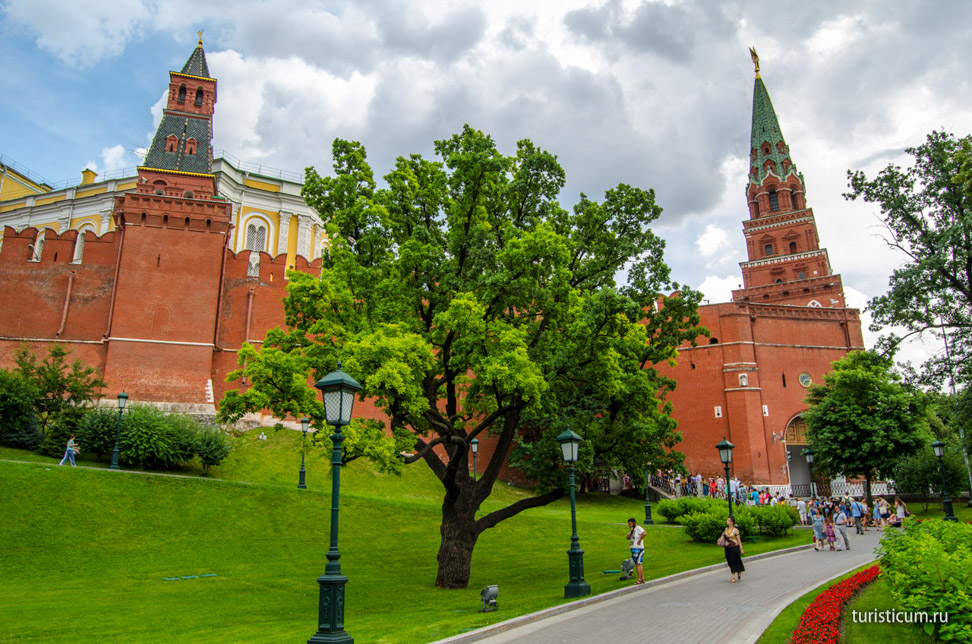
One can clearly see the rampart here that used to strengthen the Kremlin walls.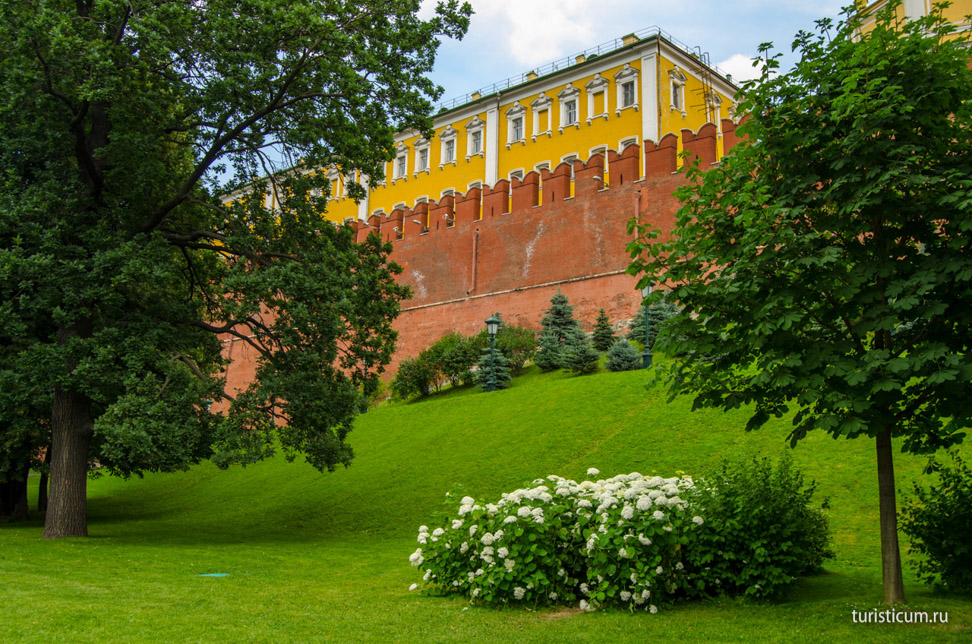
There is a Monument with bass-relief behind the mysterious trees. It commemorated the Patriotic War against Napoleon in 1812.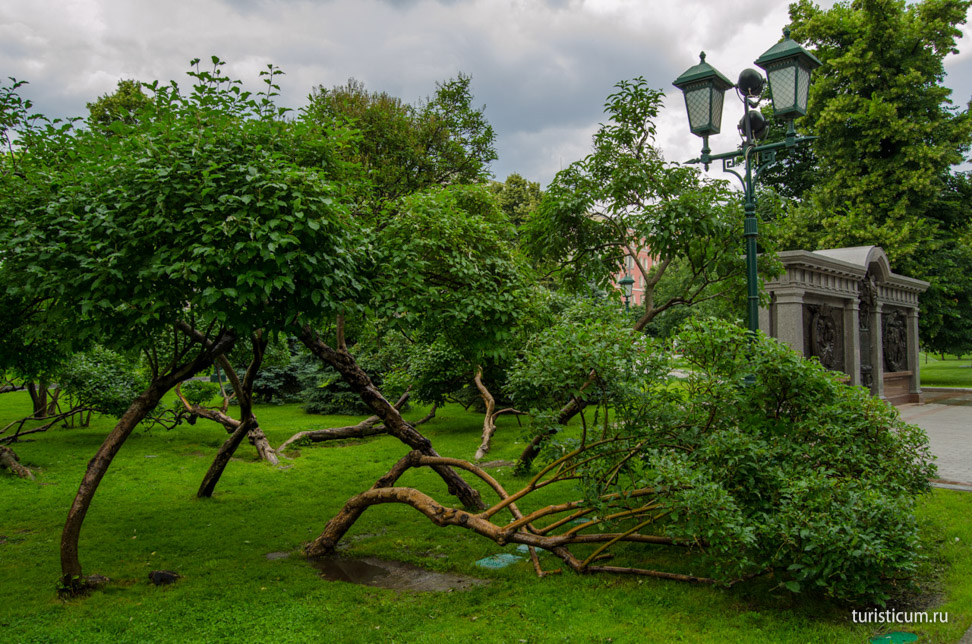
Monument to Emperor Alexander I is right in front of the bass-relief. This Monument is pretty young and only appeared here in 2014.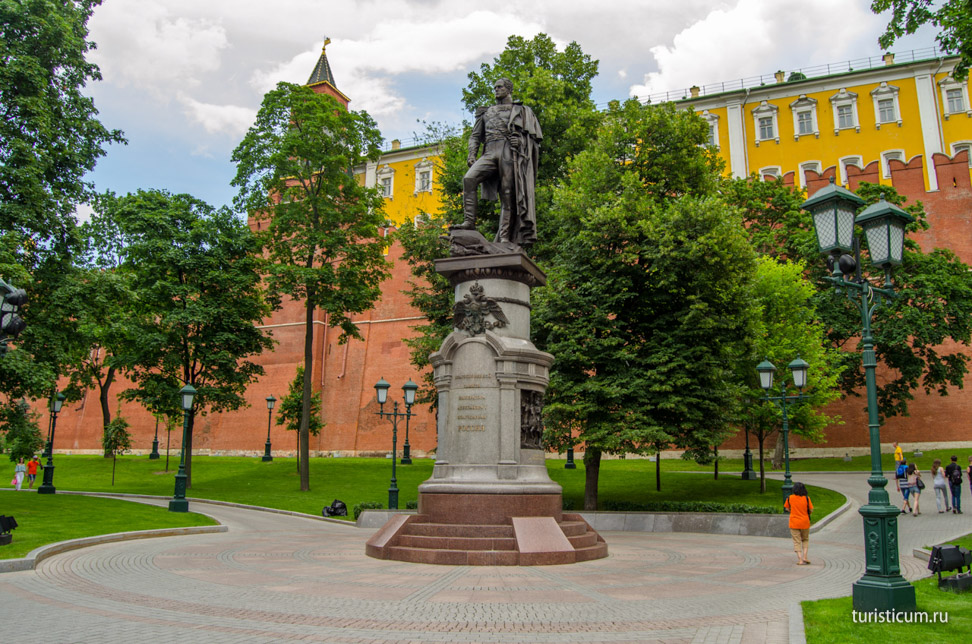
There is an Information Center further on. One can buy tickets to any museum in the Kremlin and to the Troitsky Bridge here. By the way, we shall go along the bridge on our way to the Cathedral Square.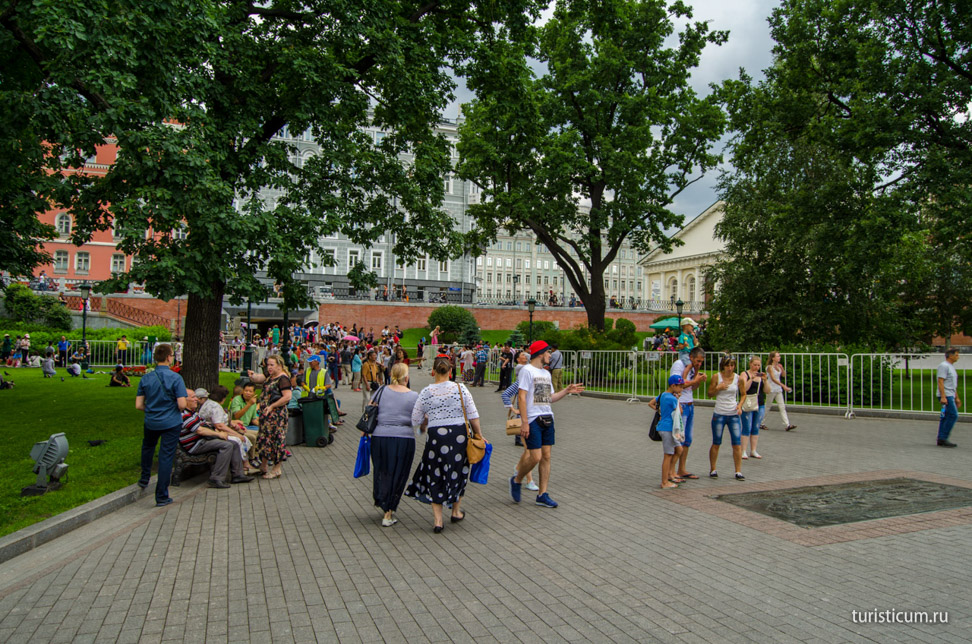
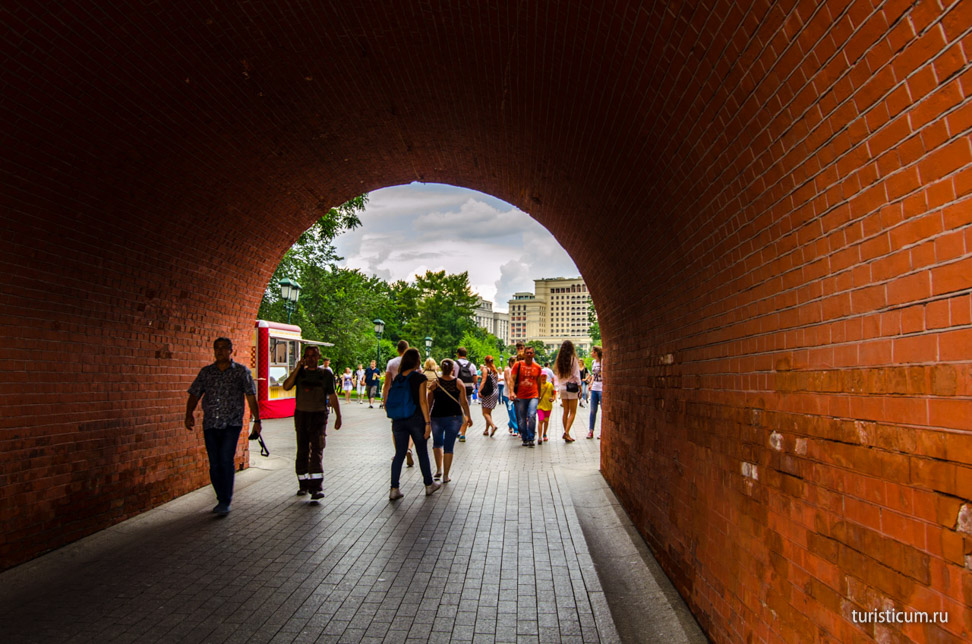
We pass modern Kremlin extension. Honor Guard teams base right behind it.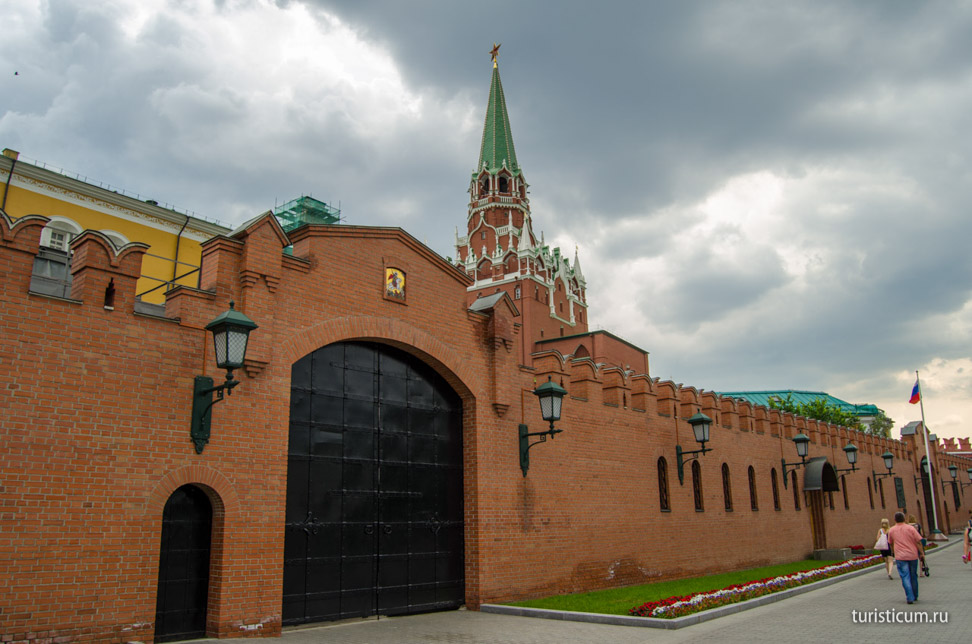
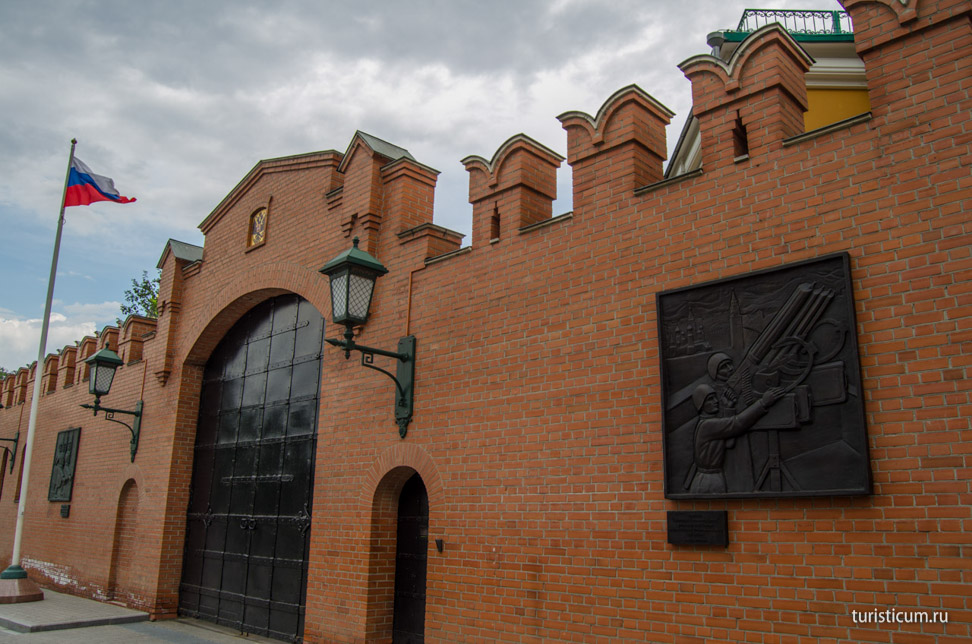
There is a beautiful flower bed and plenty of benches in front of the extension. And the Central Showroom Manege is just across the Manege Street.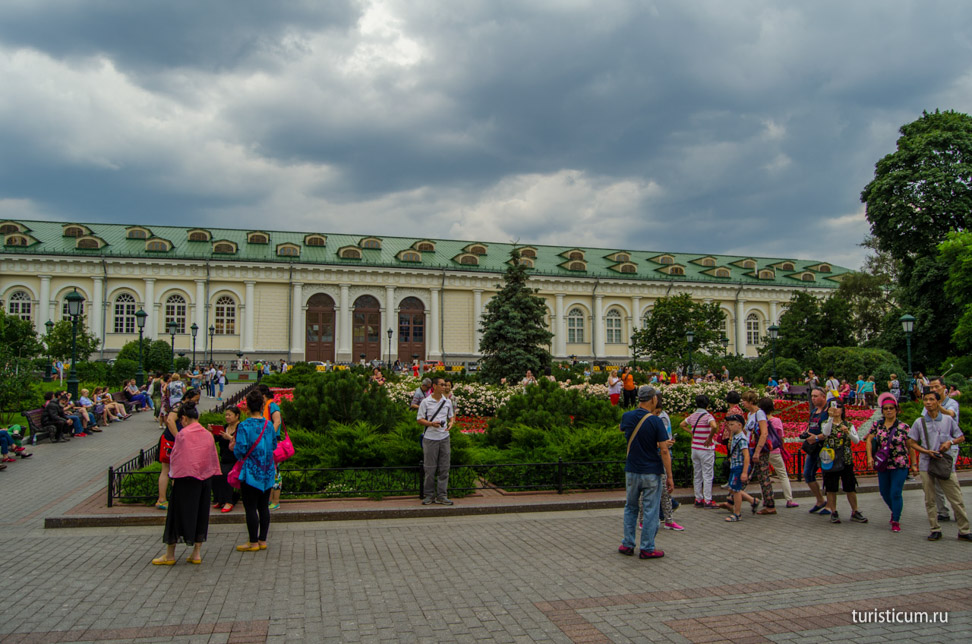
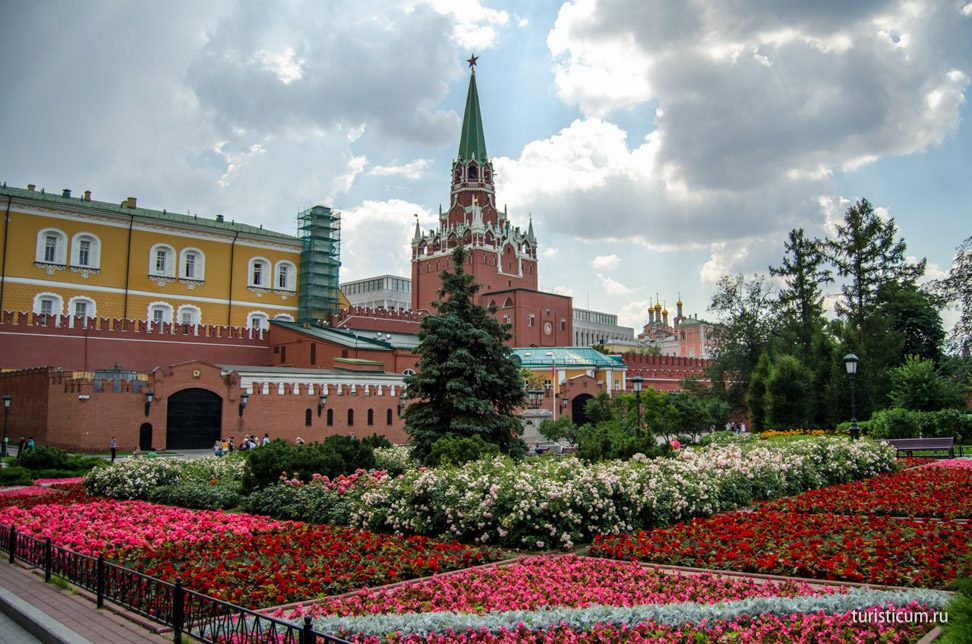
Monument to patriarch Hermogenes
There is Monument to patriarch Hermogenes a bit further from the flower bed. His role in Russian history during the Dark Years is close in its scale to that of Kuzma Minin and Dmitry Pozharskiy. Grot “Ruins” is behind the Monument to patriarch. The grot memorizes the Patriotic War against Napoleon in 1812. It was built in 1812 and symbolizes both the victory and reconstruction of Moscow.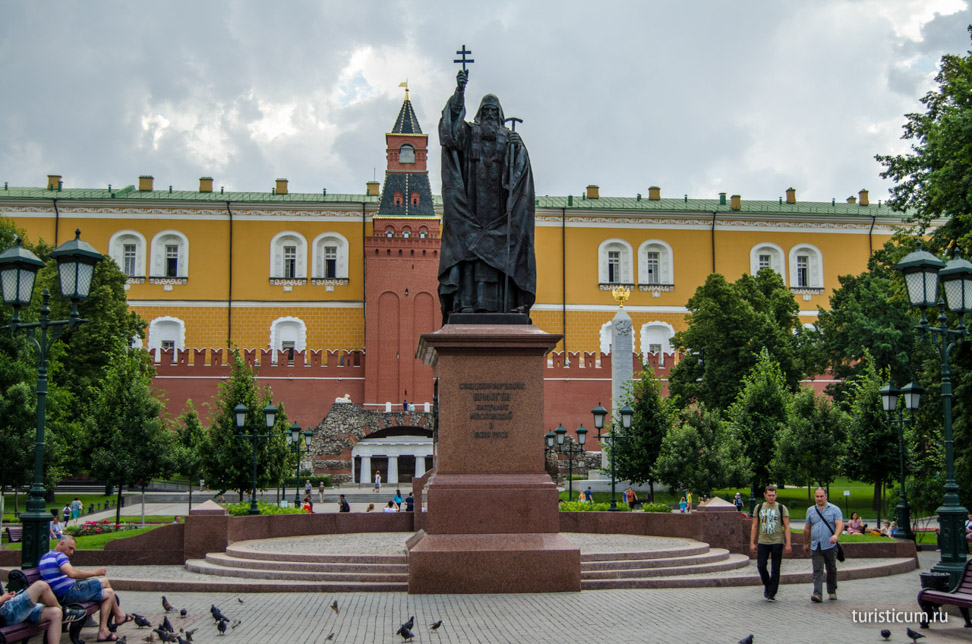
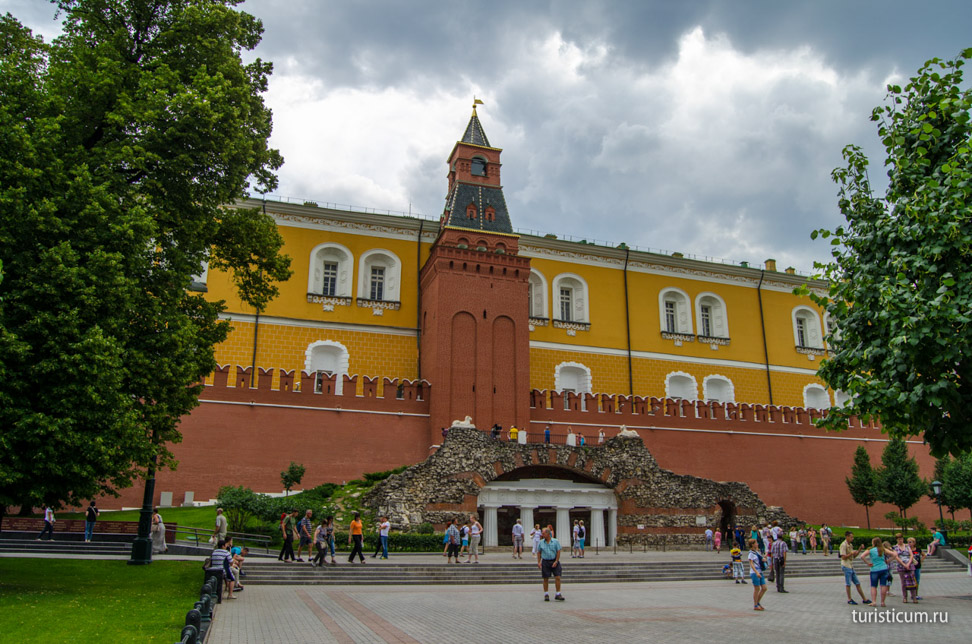
Obelisk in honor of 300 years of the House of Romanovs reign is in front of the grot. It was built in 1914. It is not surprising that after the Revolution simple operations turned the obelisk into a monument to outstanding sophists and doers who fought to free the laboring people. Its initial design was restored 110 years after the foundation.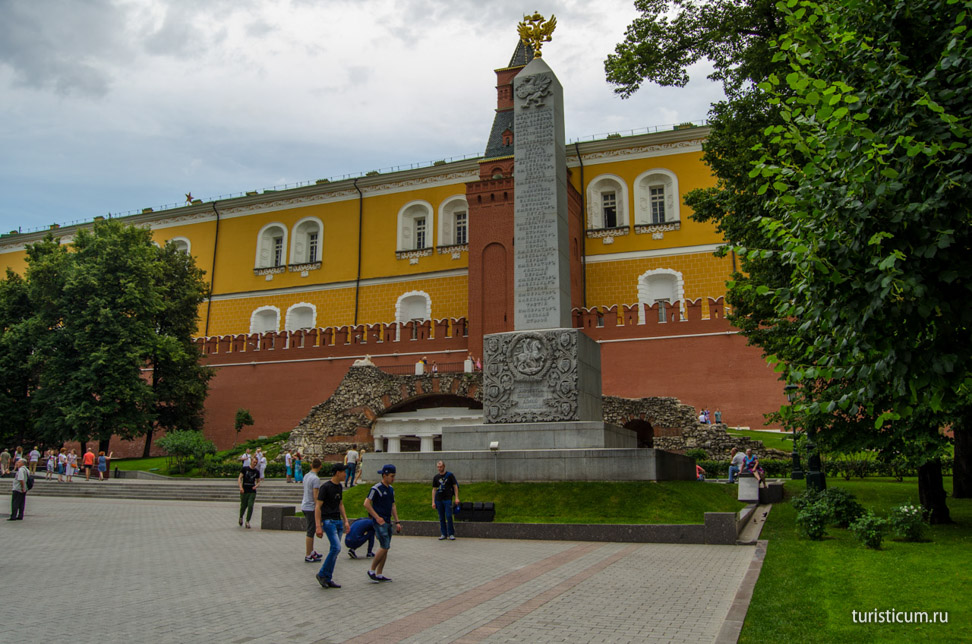
Fountains of Alexander Garden
After the Monument to patriarch Hermogenes we head towards the fountain beloved by all the guests of the capital.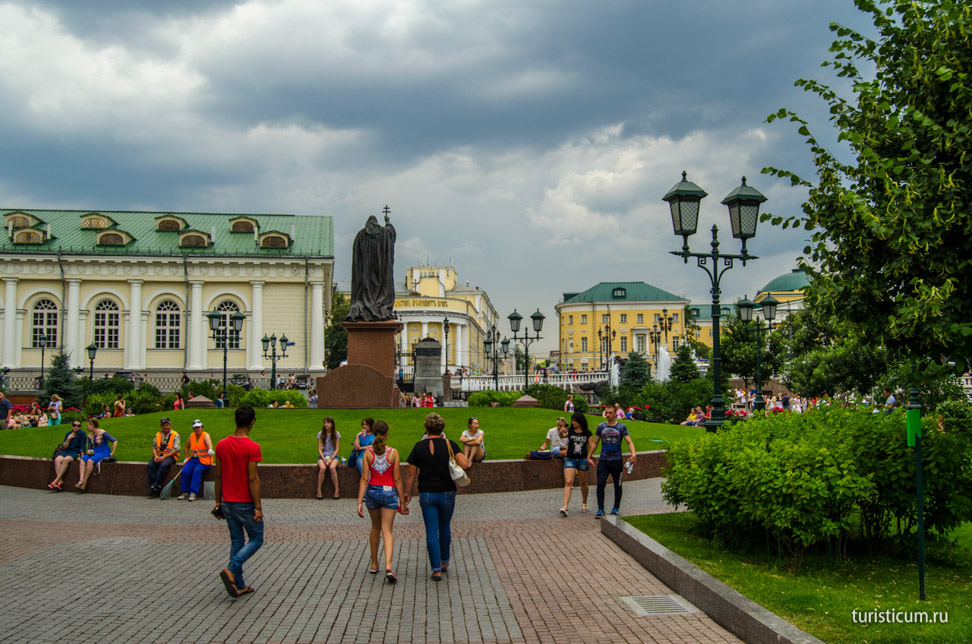
The sculpture of four horses stands in the center of the fountain. They symbolize seasons. The way the fountain ejects water into the air motivated its name – “Geyser”.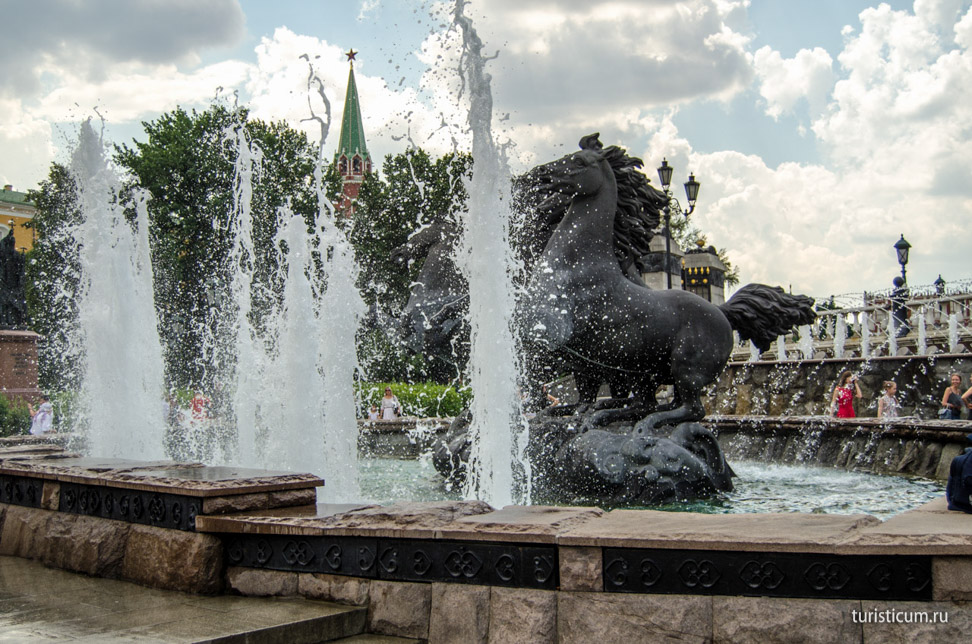
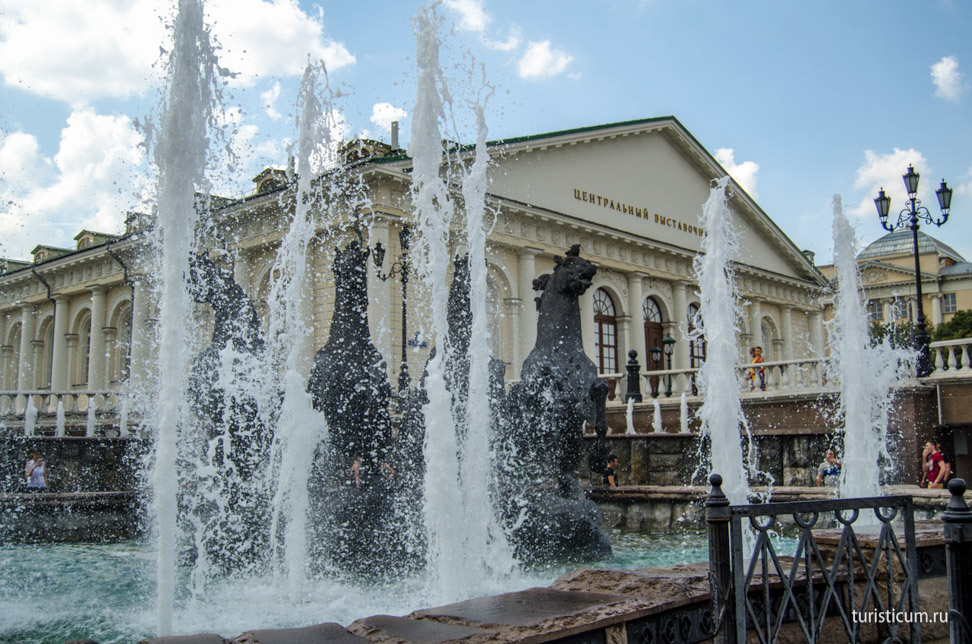
This part of the fountain is “Arcade”. Streams of water form a kind of arcades over the path where people are walking. There is no better place in Moscow to refresh oneself on a hot summer day.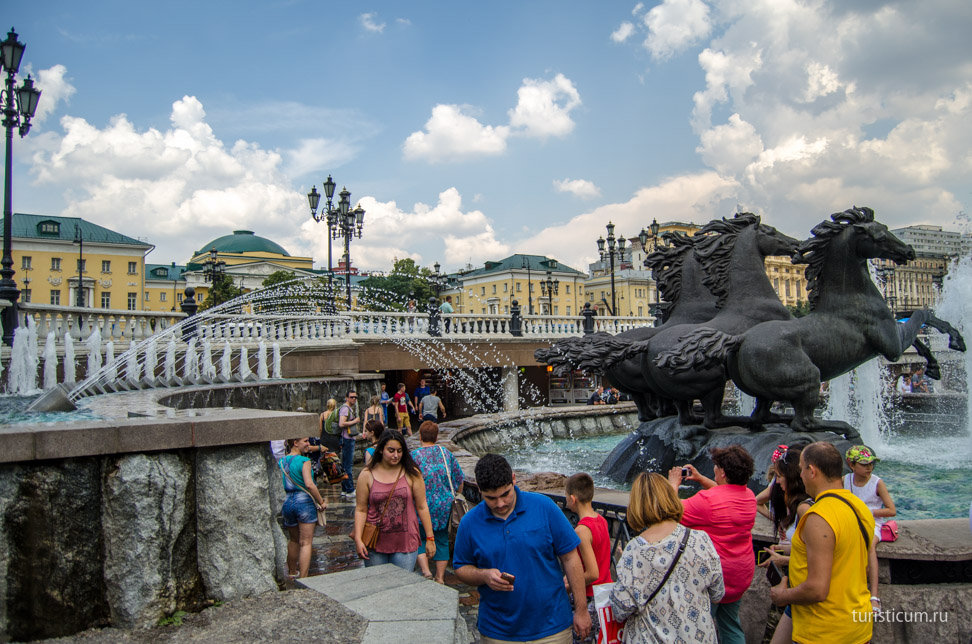
We go further along the trading center “Okhotnyy Ryad”. Here is another fountain “Neglinnaya River”. The name roots back into the fact that the fountain is a part of Neglinnaya riverbed. The river became hidden two centuries ago during reconstruction of Moscow after the war in 1812. It is now under the ground in a tube. And its fountain today is decorated with numerous sculptures of Russian fairy-tale heroes, footbridges, decorative banisters and steps. All of them create cascades of water flow.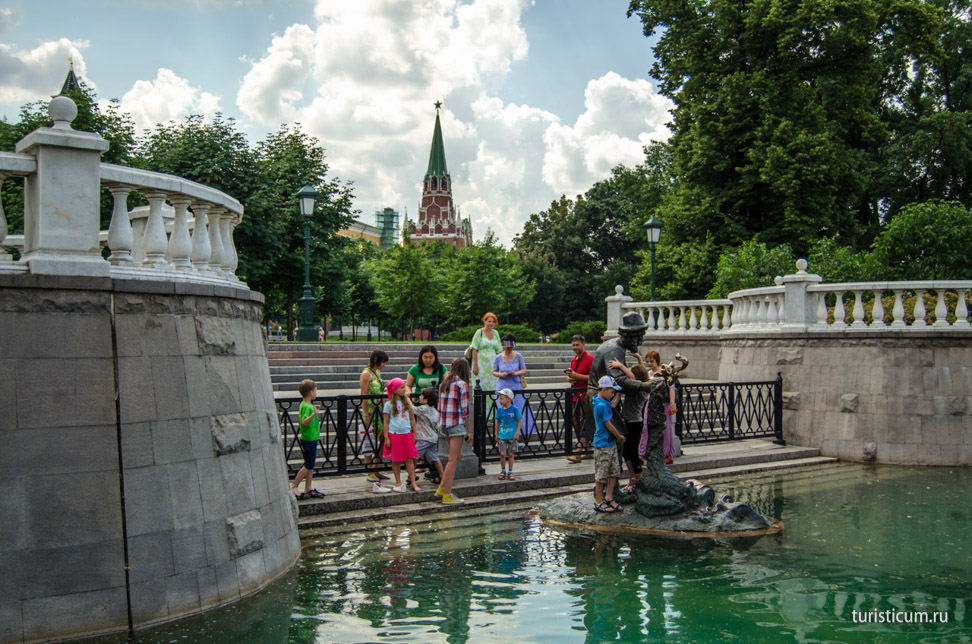
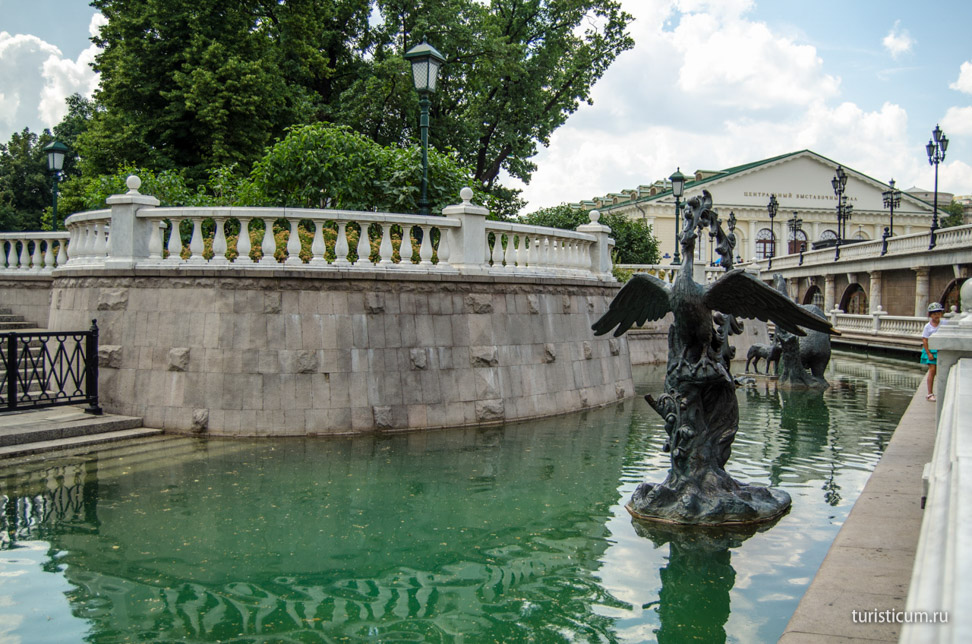
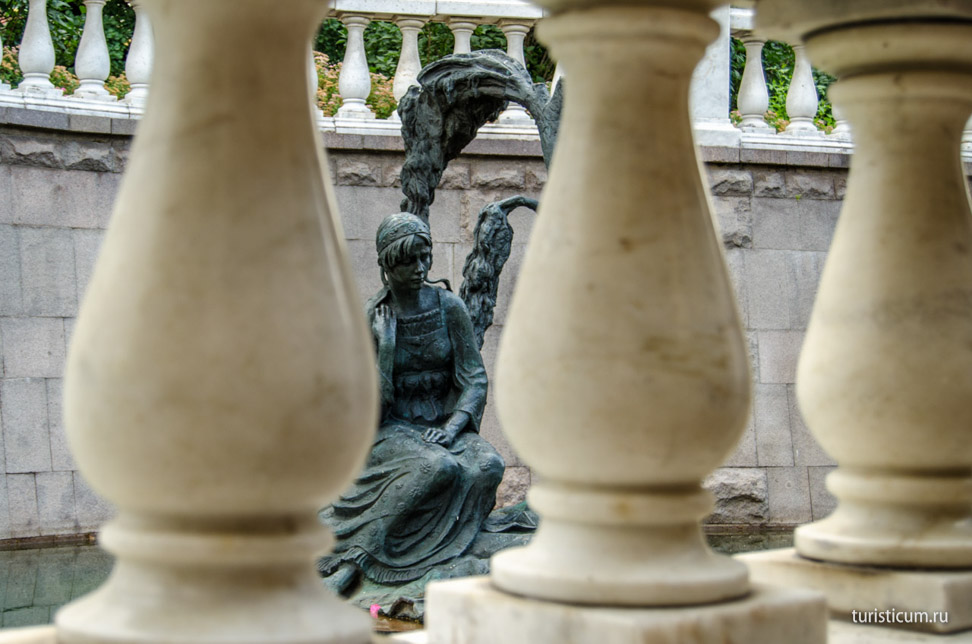
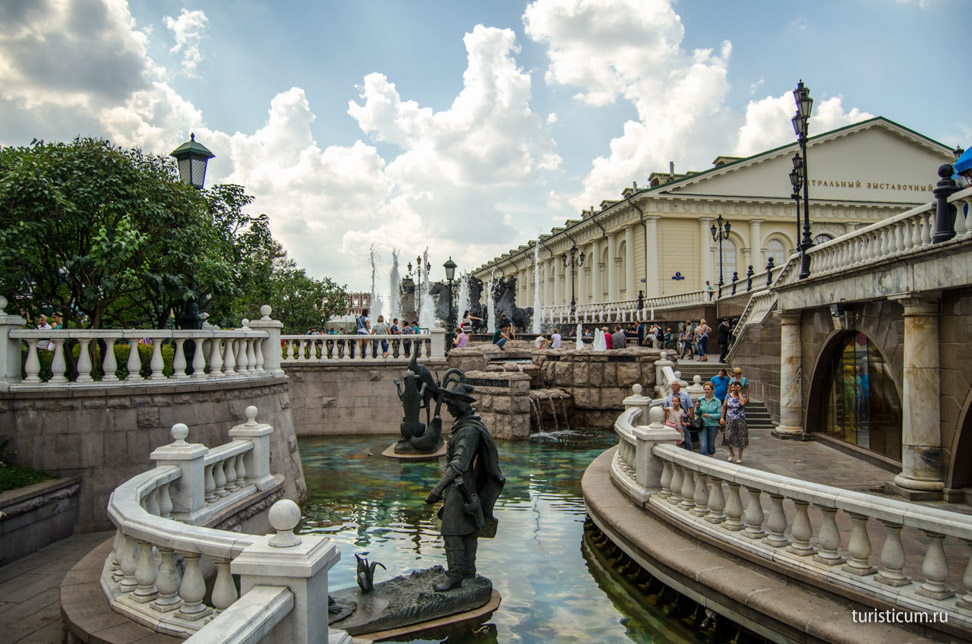
Fountain “Grot” completes the fantasy with sculpture of a mermaid lying on flowers. It is the famous artist Zurab Tzeritelli who created both this and the previous fountains.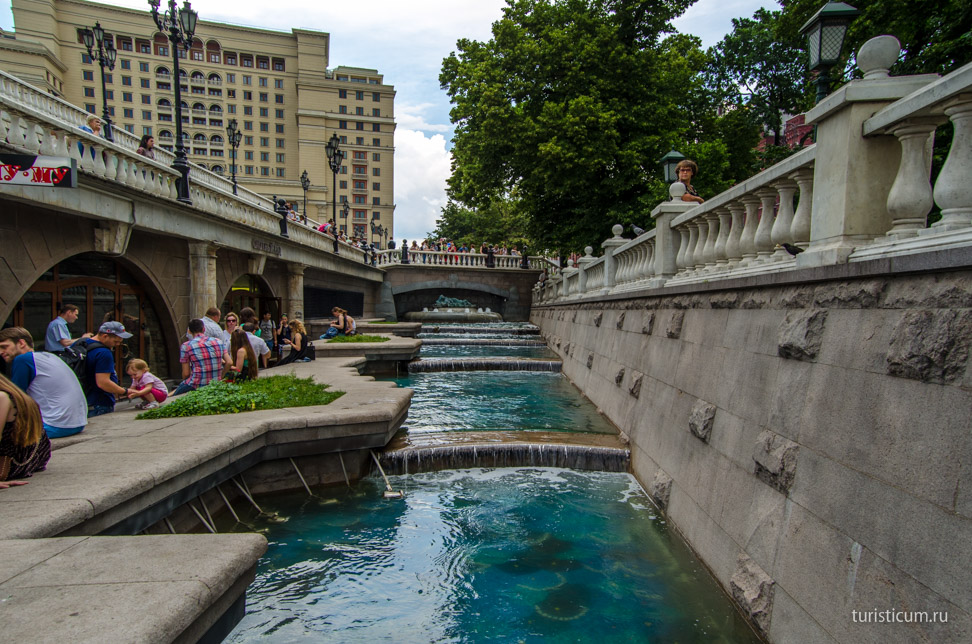
Eternal Flame in Moscow
Apart from Monuments devoted to the Patriotic War against Napoleon in 1812, Alexander Garden also commemorates the World War II. Here is the post of Honor Guard at the Eternal Flame by the Tomb of the Unknown Soldier. It is the main guard post in the Russian Federation – Post №1. Soldiers from the Presidential Regiment stand guard here daily from 8 a.m. till 8 p.m. Guard relief is performed hourly regardless of season or weather conditions. There are also stands with the ground from all Hero-towns nearby.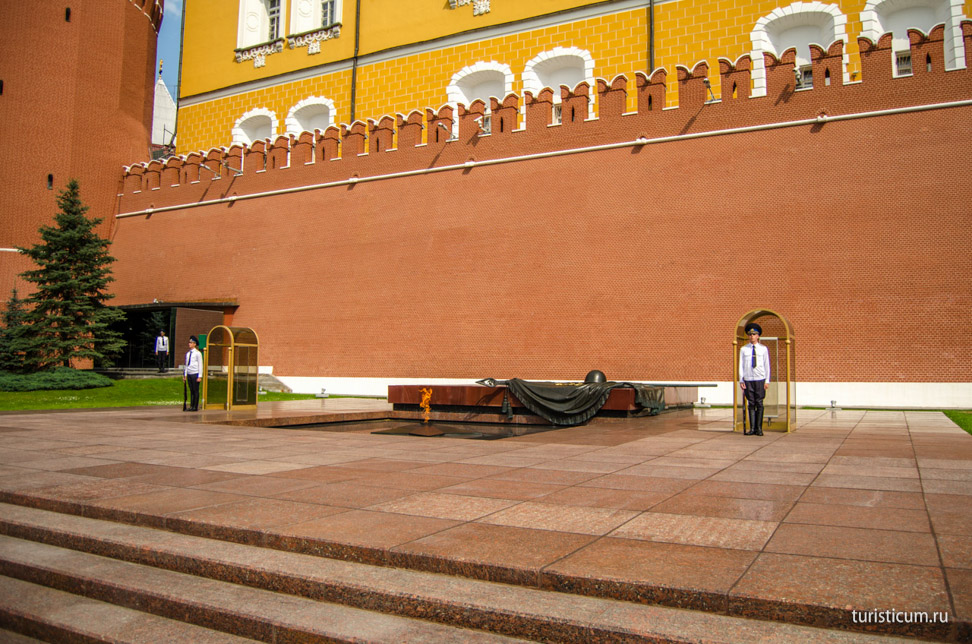
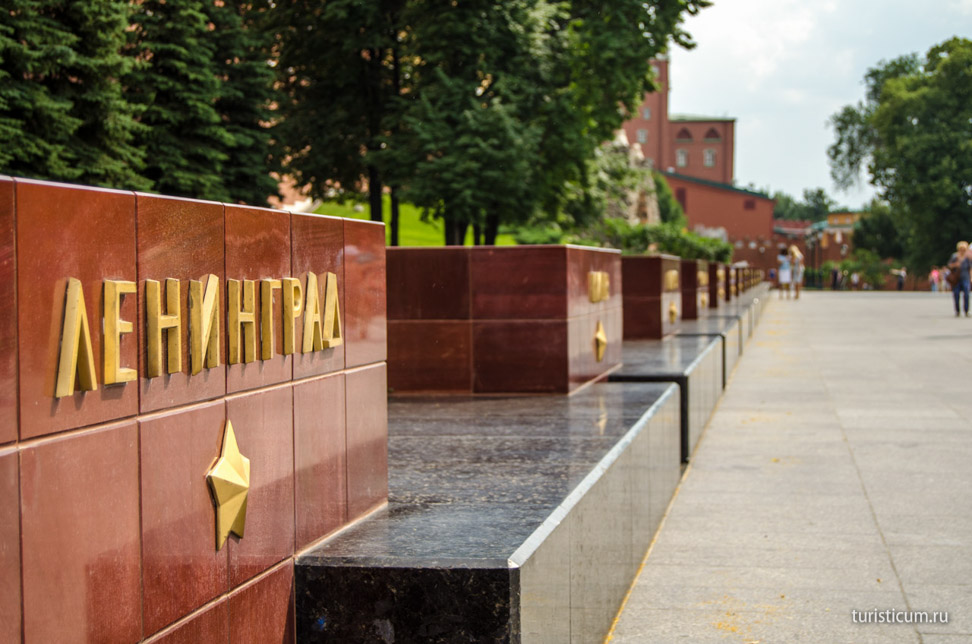
Iron gates and railing create a symbolic border of Alexander Garden. A plan of the garden is embedded into paving tile just before the entrance. This is the place where we finish the first part of our journey and begin the second one.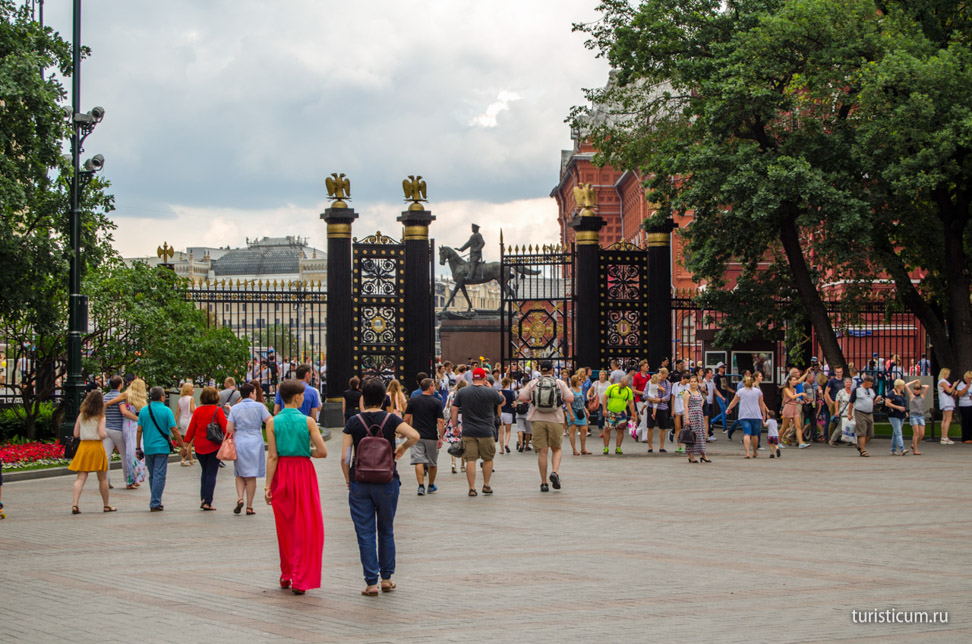
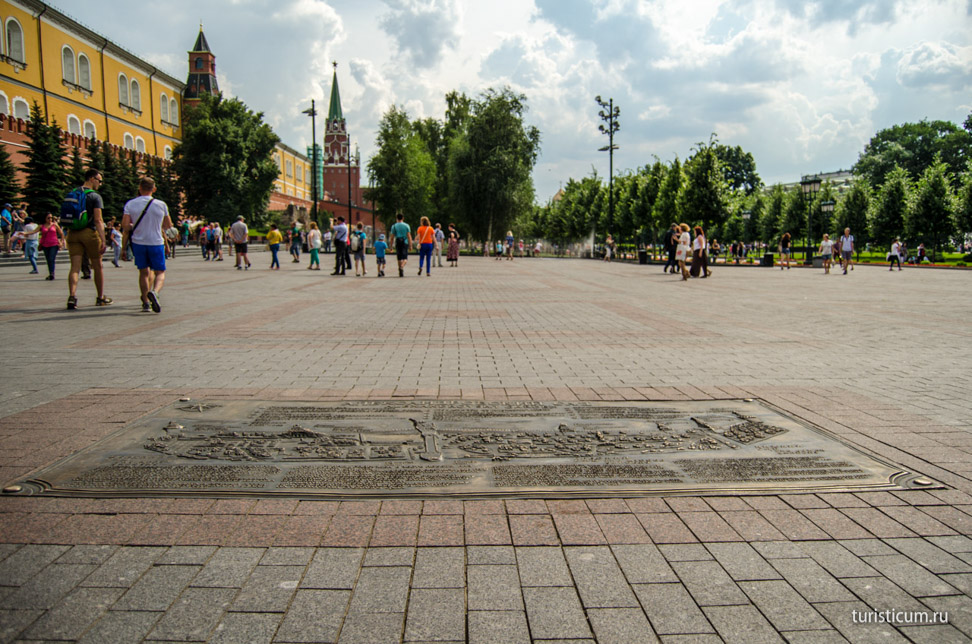
Manege Square in Moscow
Manege Square (its above-ground part) is the place where numerous fairs are held. The underground part of the square is the trading center “Okhotnyy Ryad”. Metro station “Okhotnyy Ryad” is here as well. Centerpiece of Manege Square is the State Museum of History. There is a Monument to the great soviet Marshall Georgiy Zhukov in front of the building.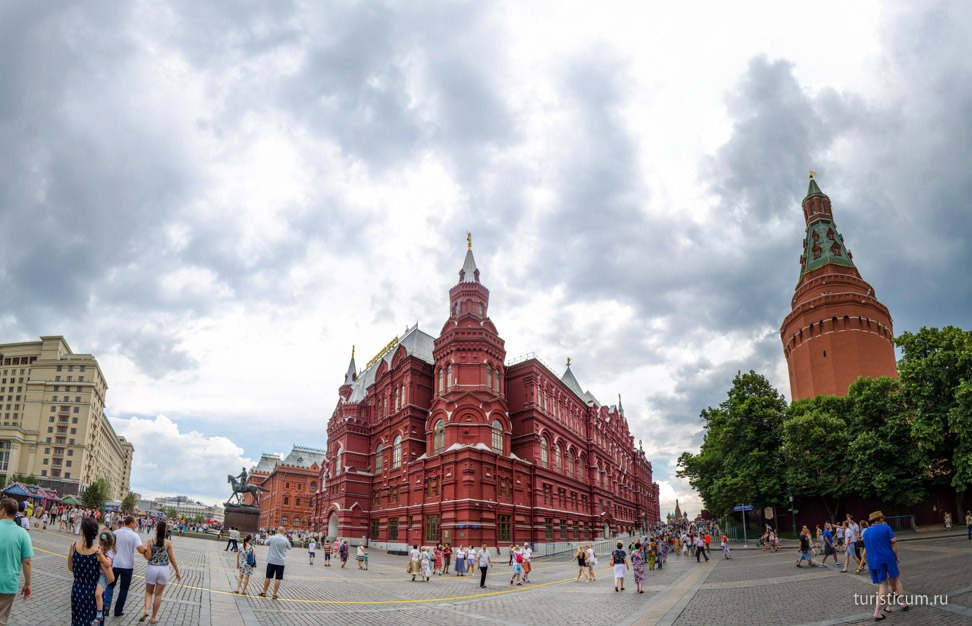
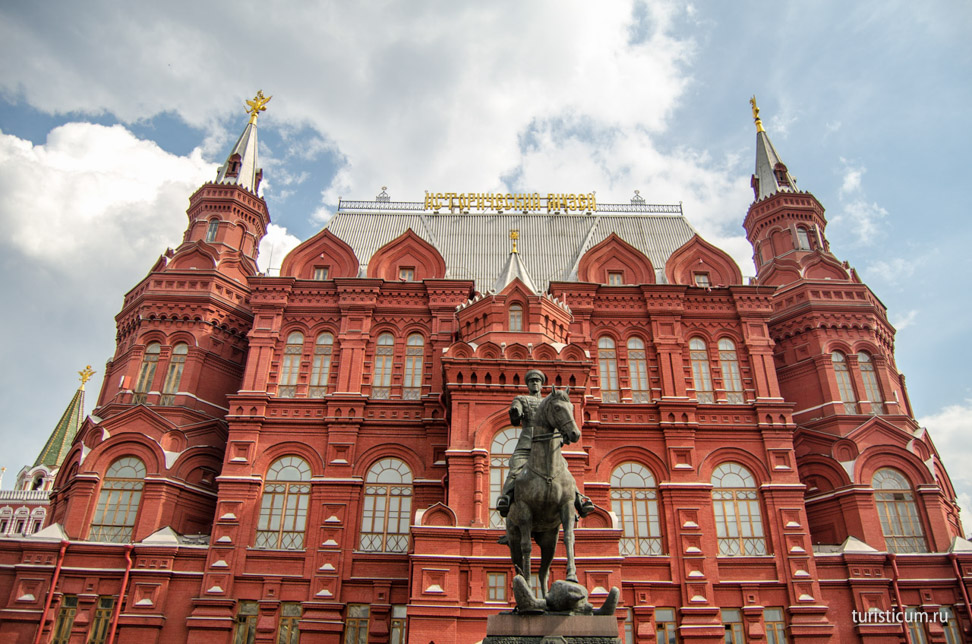
Another museum devoted to the Patriotic War against Napoleon in 1812 is on the left of the State Museum of History. The building dates back to the end of the 19th century. Voskresenskie Gate is right between the two museums. The gate took its place in 1535 and could be the oldest building in the Moscow Kremlin unless its destruction in 1931. Voskresenskie Gate used to be a part of a wall that fenced Kitay-gorod. Reconstruction of the gate only adds up to the overall beauty of Manege Square.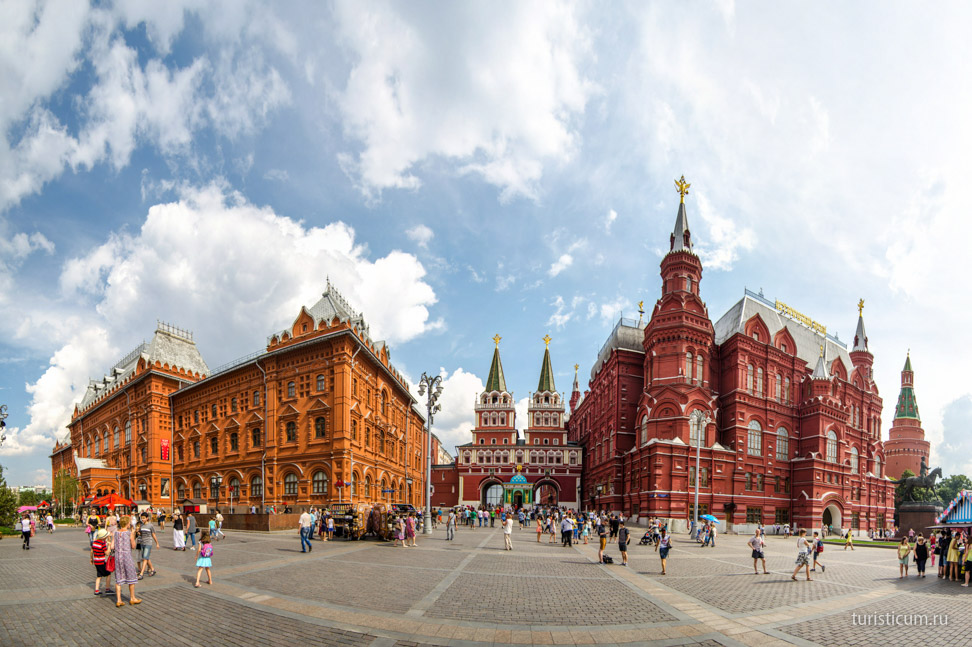
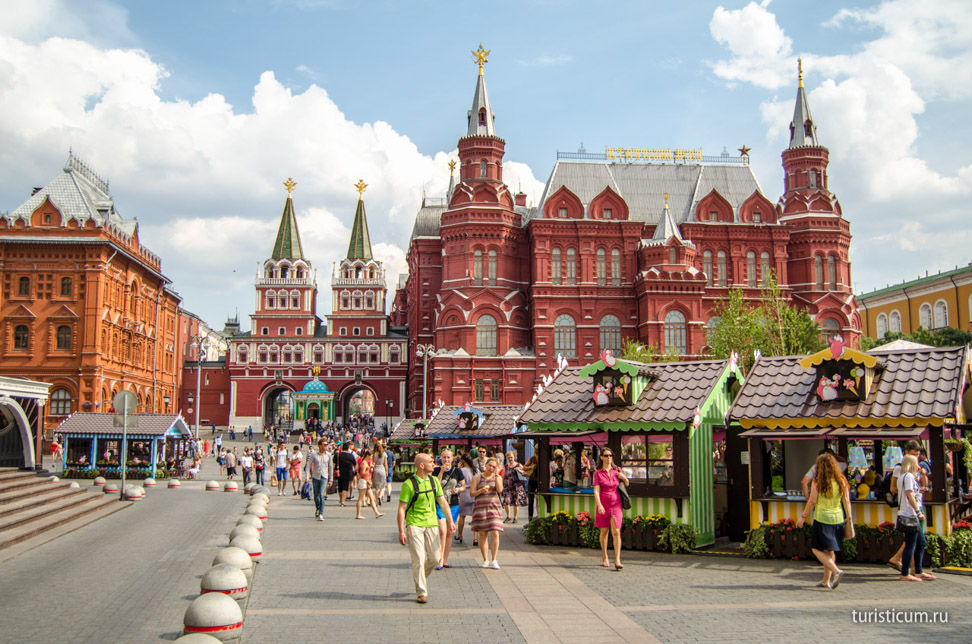
There is a bronze plague in front of Voskresenskie Gate. It is the Russia’s Kilometre Zero. At least this is exactly that is states.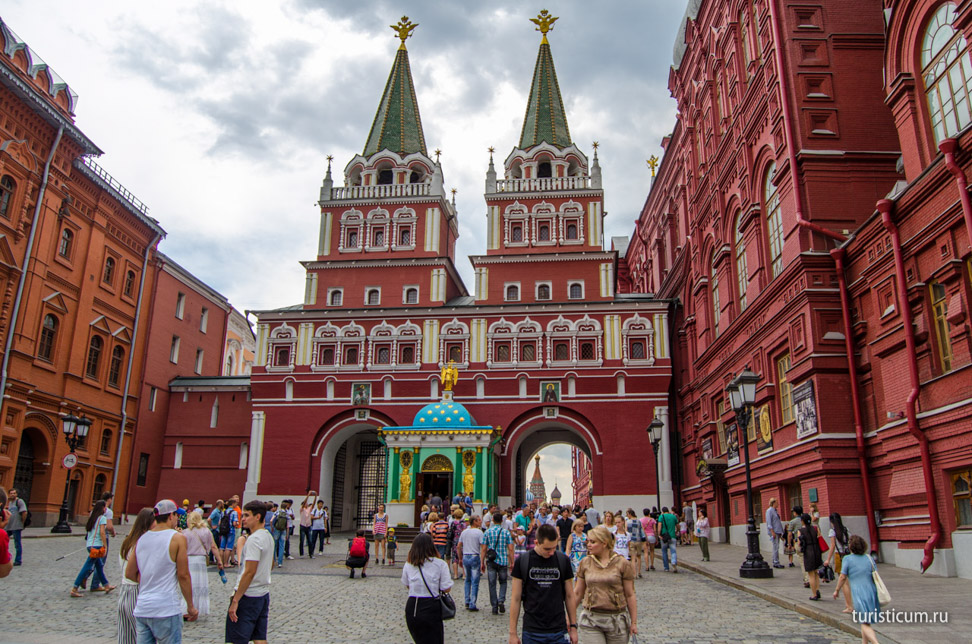
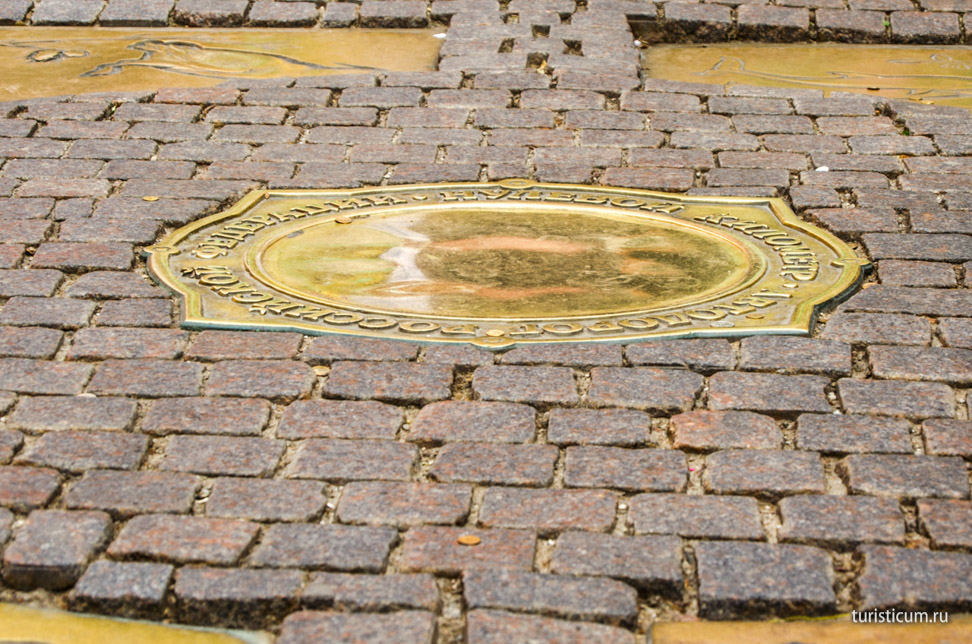
The Red Square, Moscow
We pass the gate and find ourselves at the Red Square. Here I had a feeling that I did not often experienced in my everyday life – the feeling of childish excitement, elation and happiness. At least this is what I felt when I first came to the Red Square. The reason for this might be hidden in the amount of idle strollers, most of whom came from abroad, or it might also be in some vibes emitted by the red-brick walls or the paved cubes.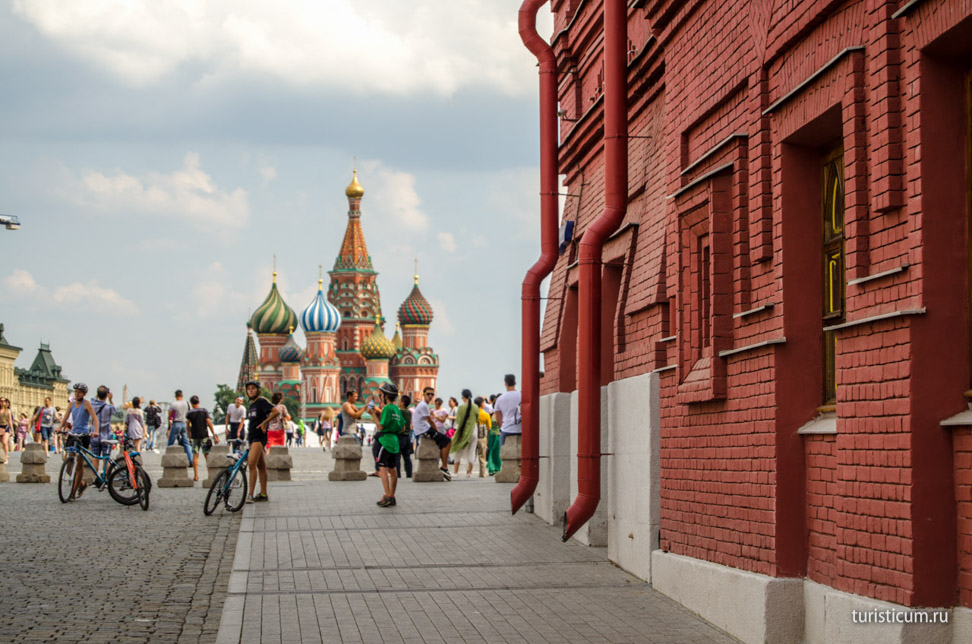
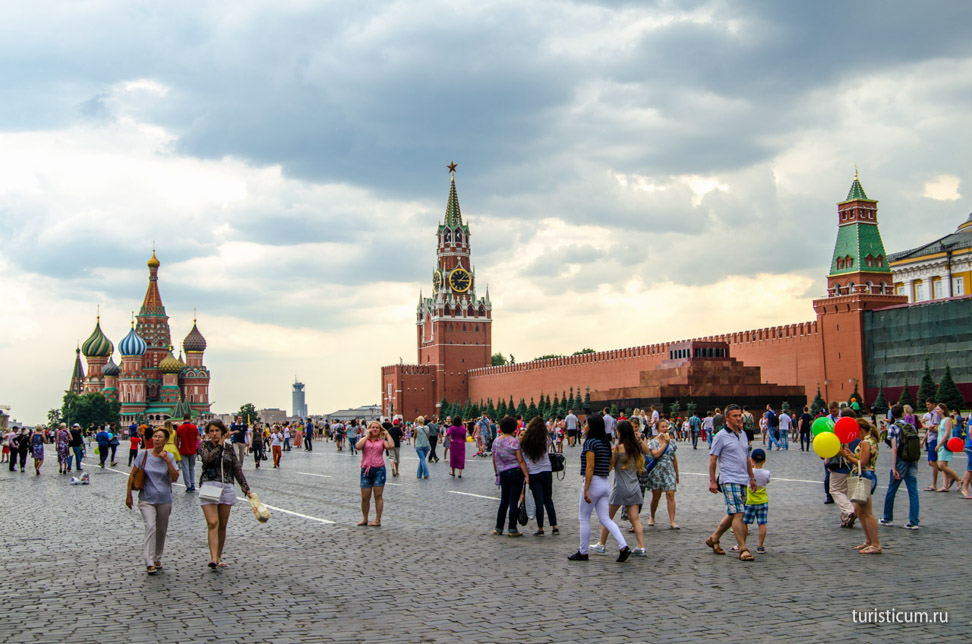
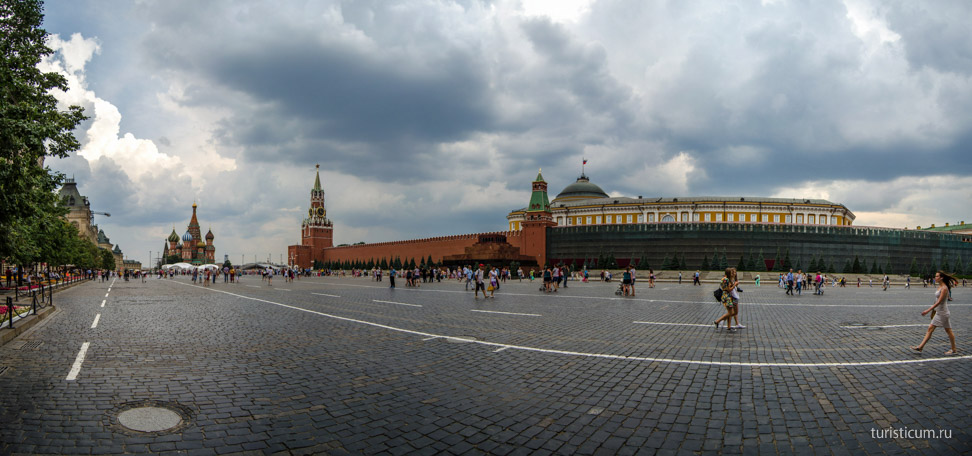
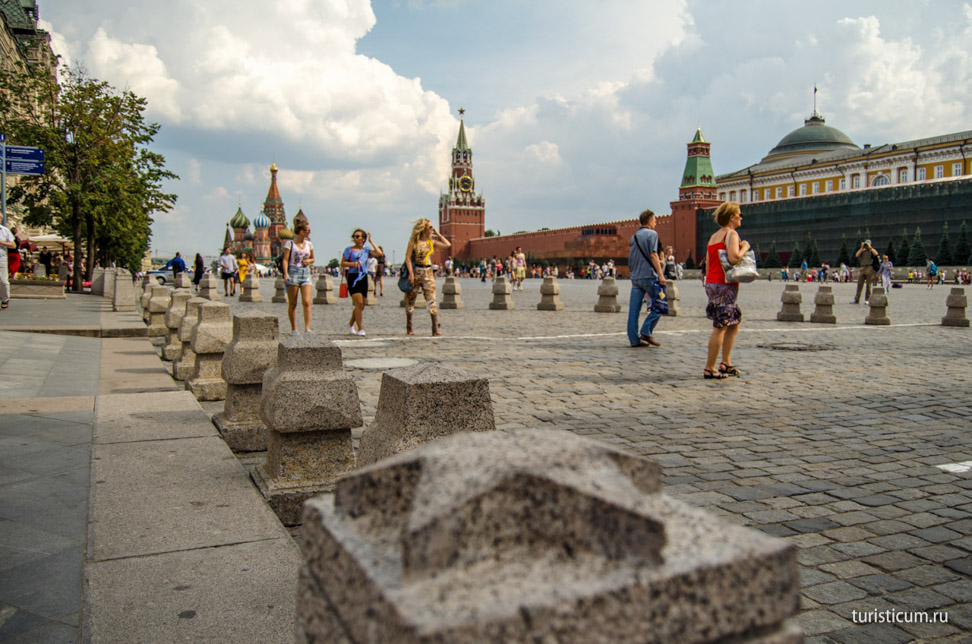
There is Nikolskaya Street on the left of the entrance to the Red Square. It used to be carriageable long ago, but it is pedestrian in our days.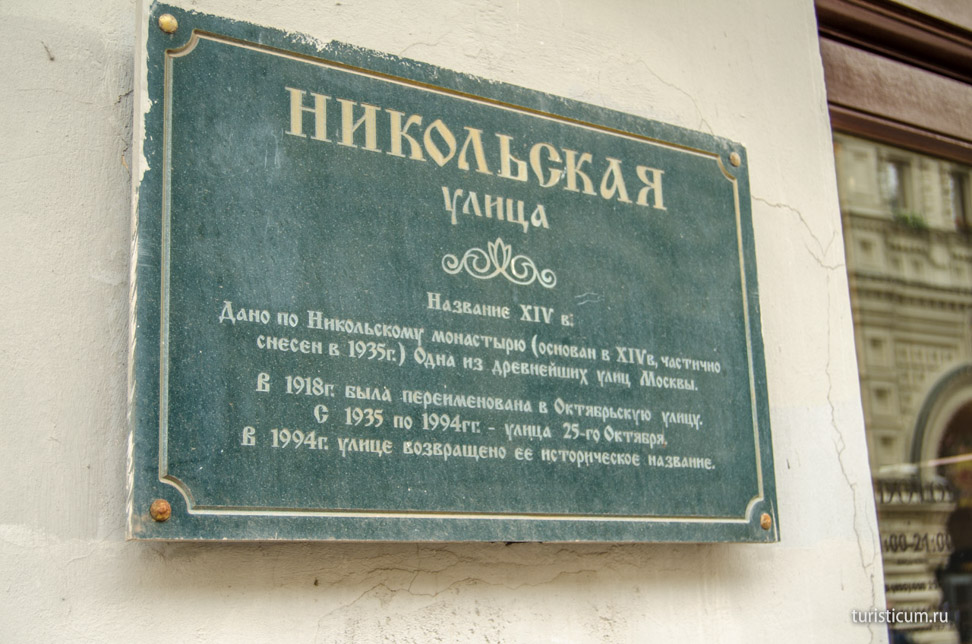
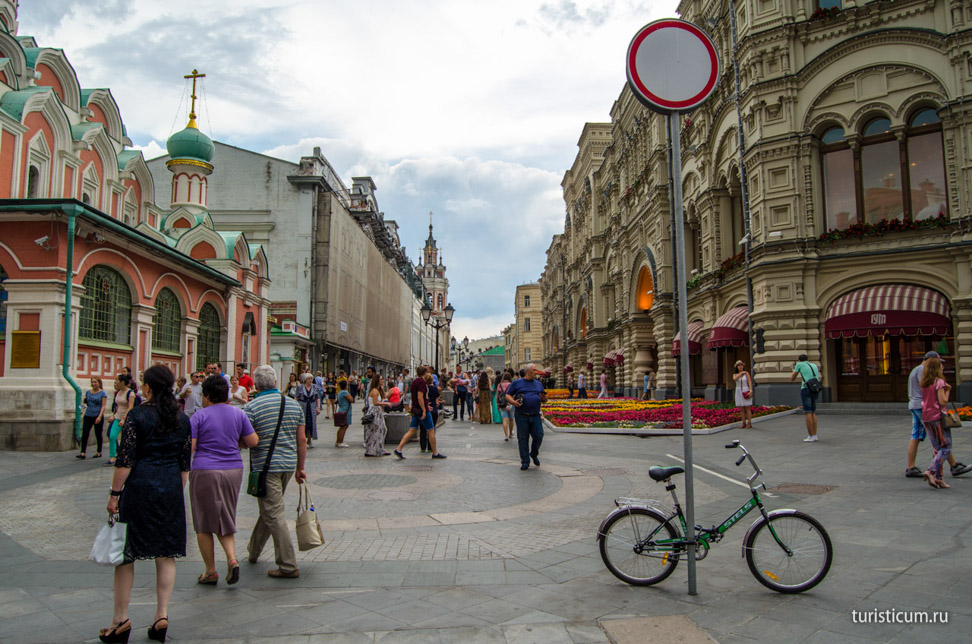
Here is also the Chapel in Honor of the Kazan Icon of the Mother of God.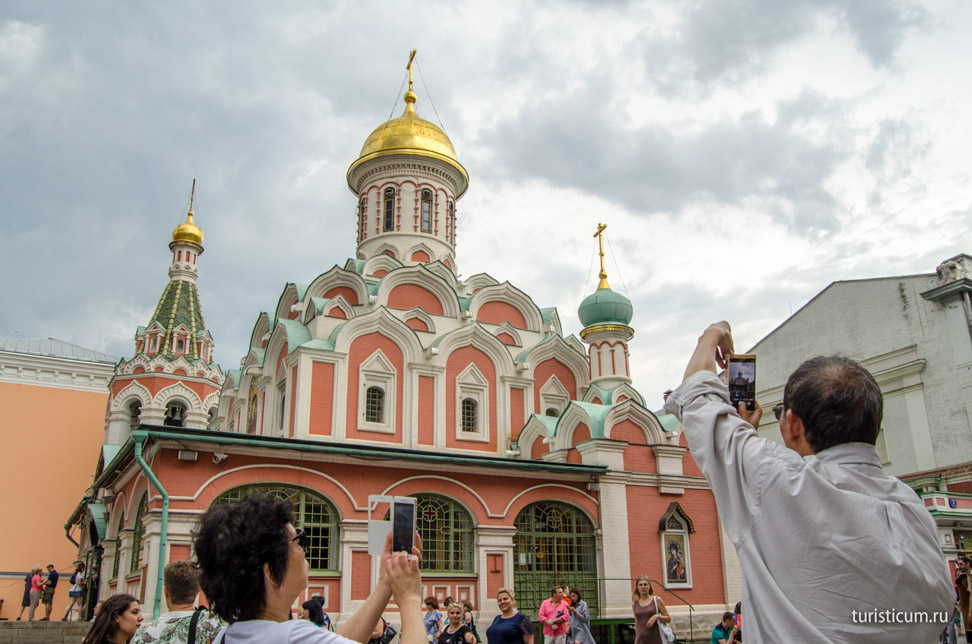
GUM, Moscow
Nikolskaya Street is also famous for the fact that here is the entrance to the main department store of the country – GUM. An abbreviation of Russian: Главный универсальный магазин, tr. Glavnyj Universalnyj Magazin, literally “main universal store. The building, completed in 1896, remained safe and sound till our days. Though its upper floors were constructed before the Moscow Fire in 1812. GUM also performed the function of shared accommodations right after the Revolution and up to the 50-s of the 20th century. But the trade went on even in those times.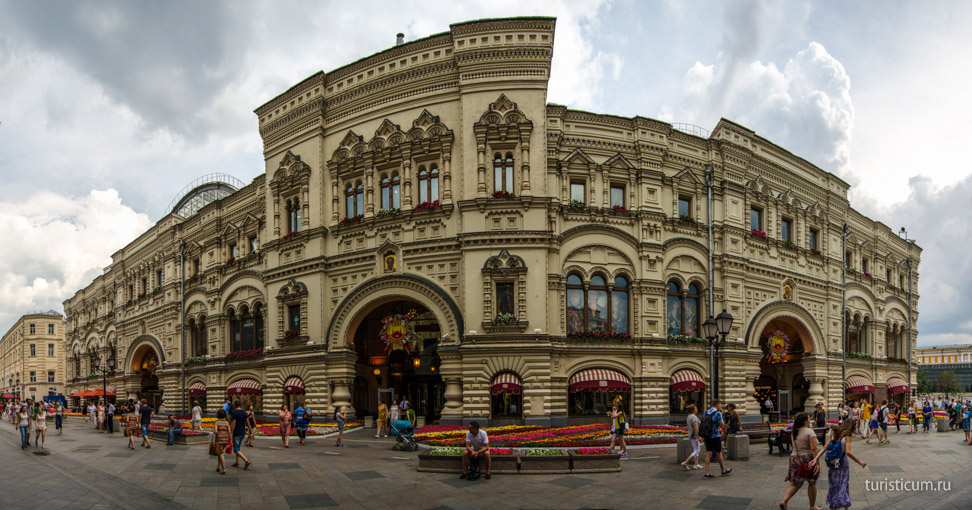
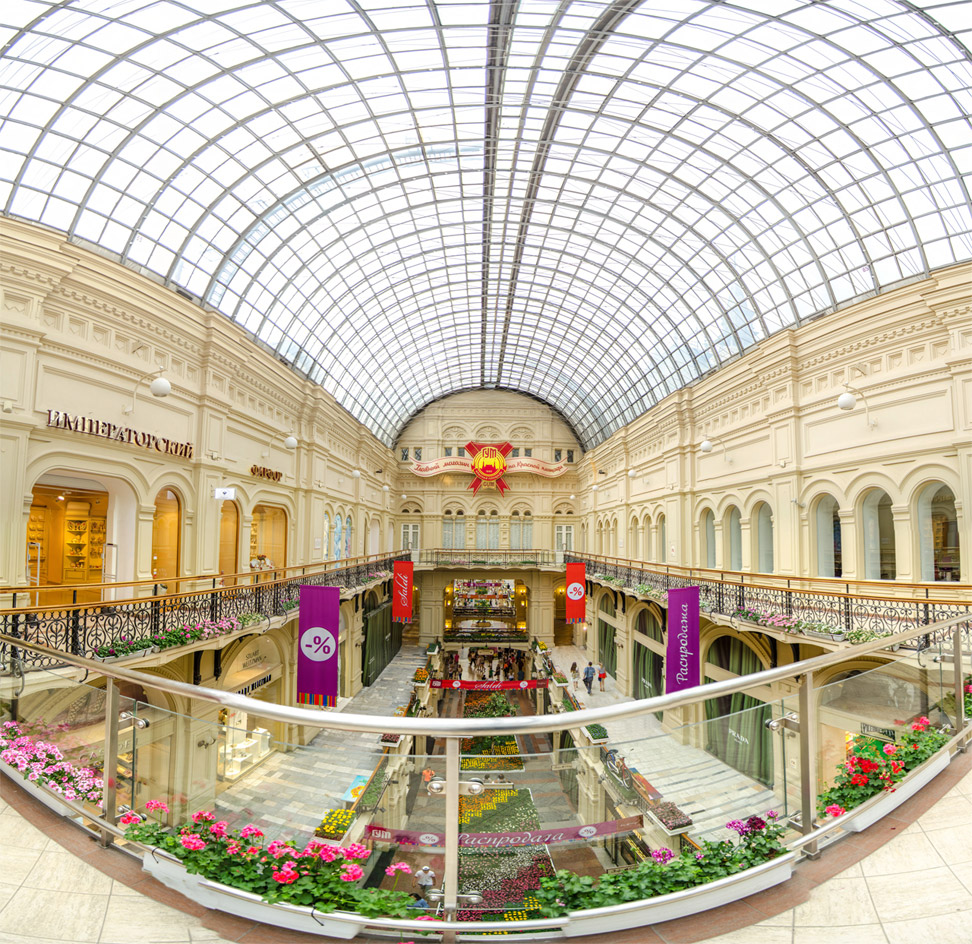
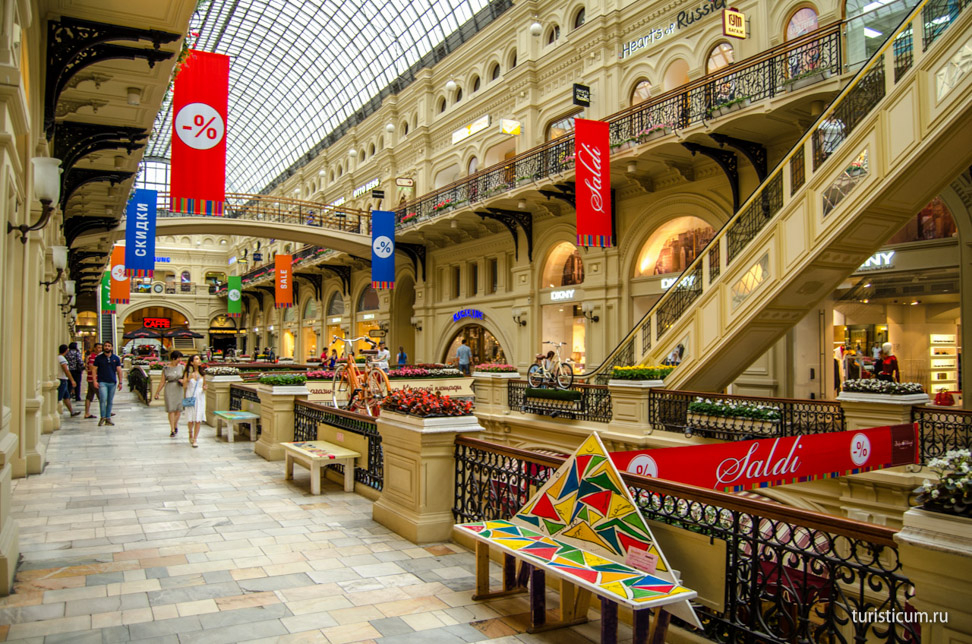
The Spasskaya Tower, Moscow
As soon as we leave GUM we find ourselves back at the Red Square. Another attraction of both the Red Square and the Kremlin itself is the Spasskaya Tower. It is the front gate of the Kremlin. The tower dates back to 1491.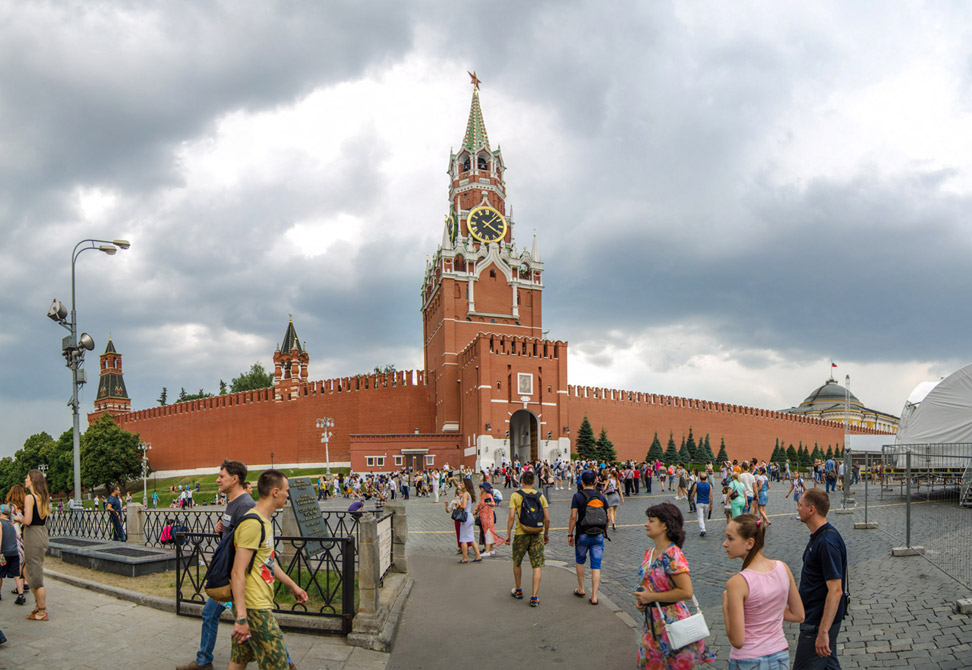
According to a tradition, the President of Russian Federation congratulates all the citizens of the country with the New Year. His speech is usually broadcasted on December, 31 and the Spasskaya Tower serves as a background for this occasion. The peal of its bells is in blood of every Russian citizen. It is a part of New Year alongside with Champagne and decorations.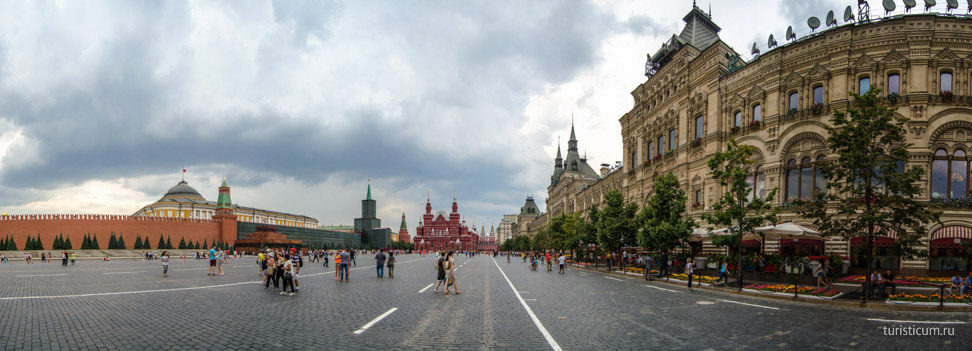
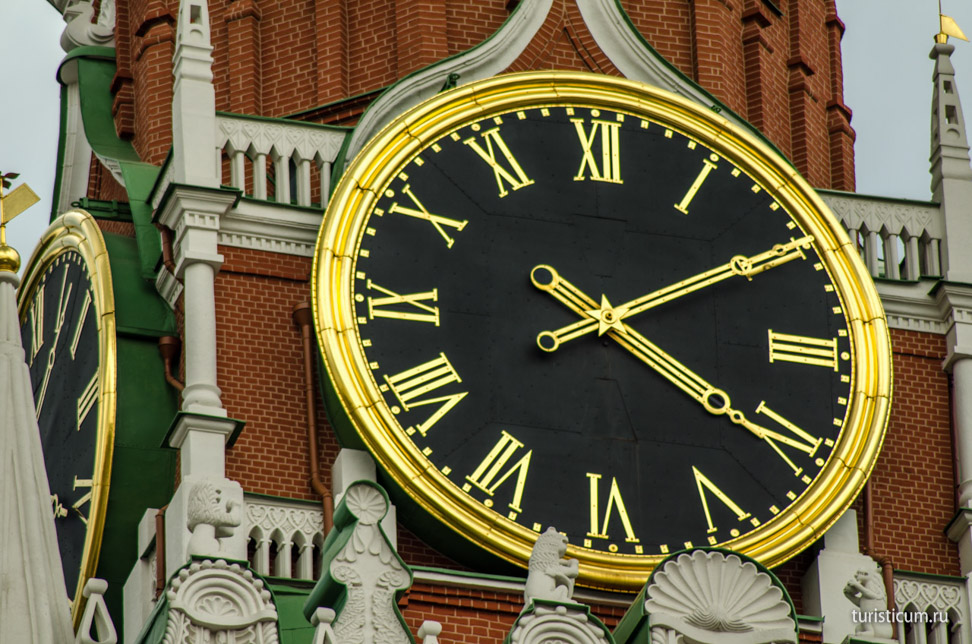
An interesting fact is that all the stars on all the Kremlin towers are made of ruby glass and are illuminated from the inside in the evenings. Besides, blasts of wind make them whirl just like weather vanes.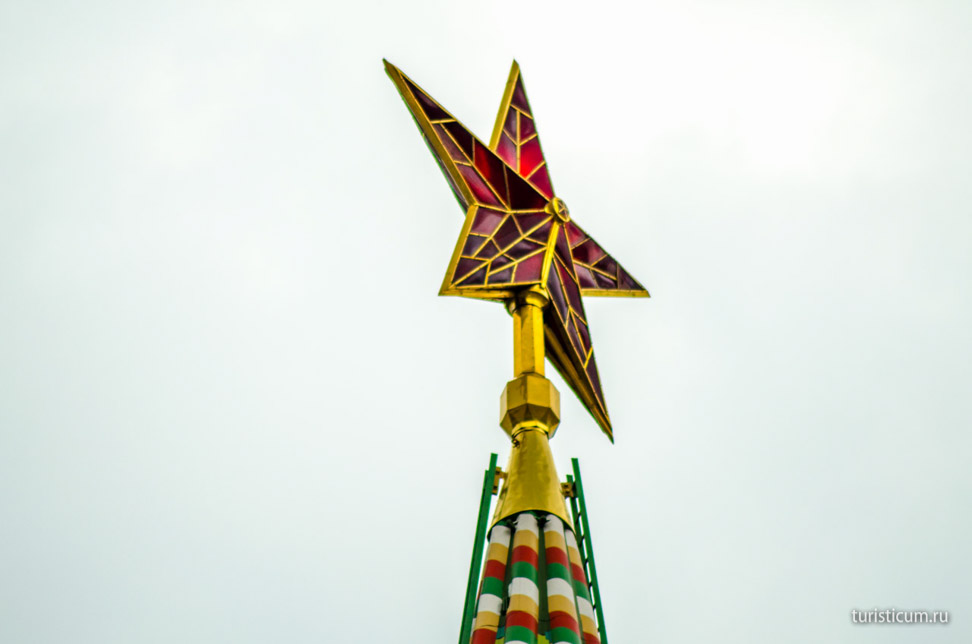
There is the Tzarskaya Tower next to the Spasskaya. Both its appearance and name are no fluke. Ivan the Terrible observed the Red Square from this tower. The stone tower fully resembles its predecessor though it only appeared after the Tzar’s death.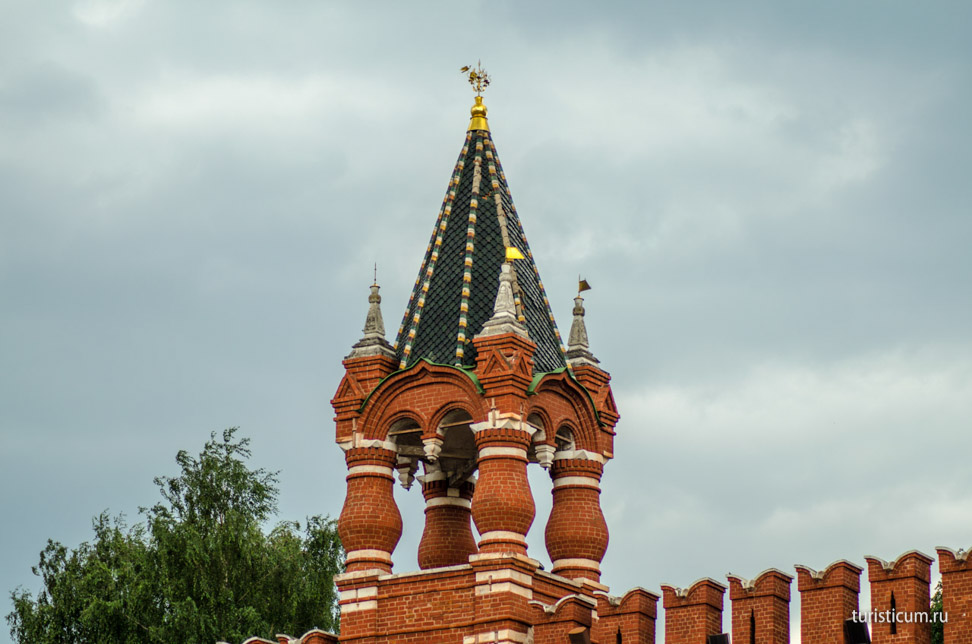
Saint Basil’s Cathedral
There is another important attraction on the opposite side of the Red Square in front of the State Museum of History. It is the Cathedral of the Intercession of the Most Holy Theotokos on the Moat – or Saint Basil’s Cathedral, as many people know it.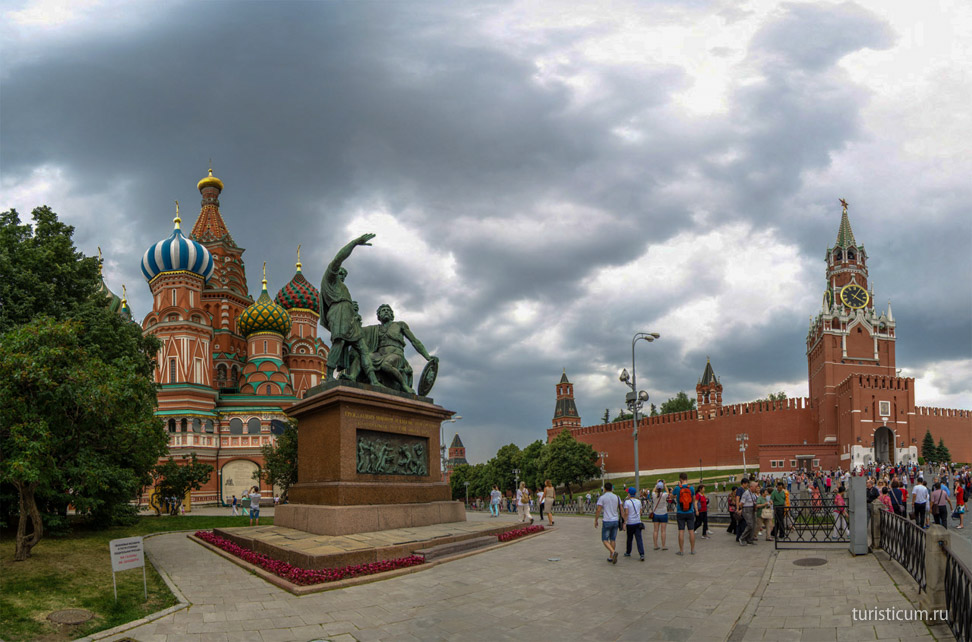
Pokrovsky Cathedral (another name of the cathedral) is on UNESCO World Heritage List in Russia. The cathedral was built in the times of Ivan the Terrible in order to commemorate the conquest of Kazan. In fact it only miraculously avoided demolition in the 30-s years of the 20th century.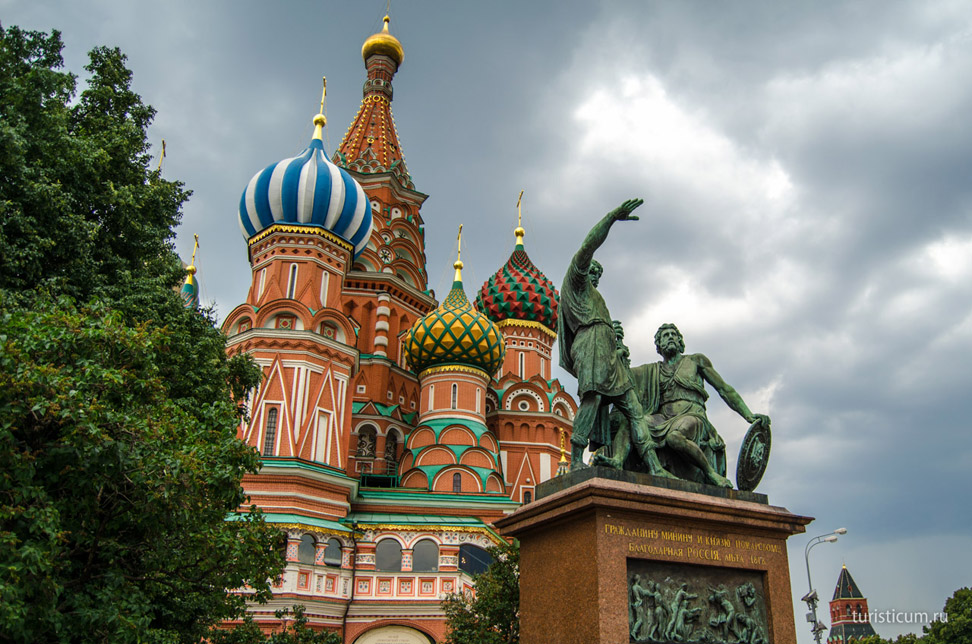
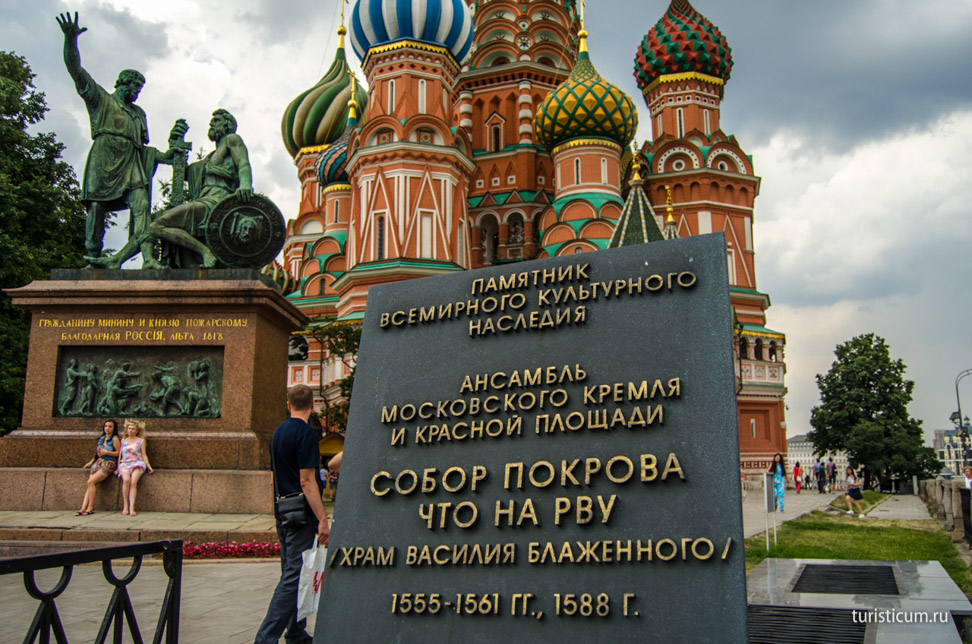
There is the Monument to Minin and Pozharsky next to the Pokrovsky Cathedral. We have all seen those numerous cards with Pokrovsky Cathedral on it and the monument is always next to it. The monument was unveiled by Alexander I in 1818 in memory of victory over Poland during the Time of Troubles. Though, anyway the monument occupied another place at the Red Square before 1931.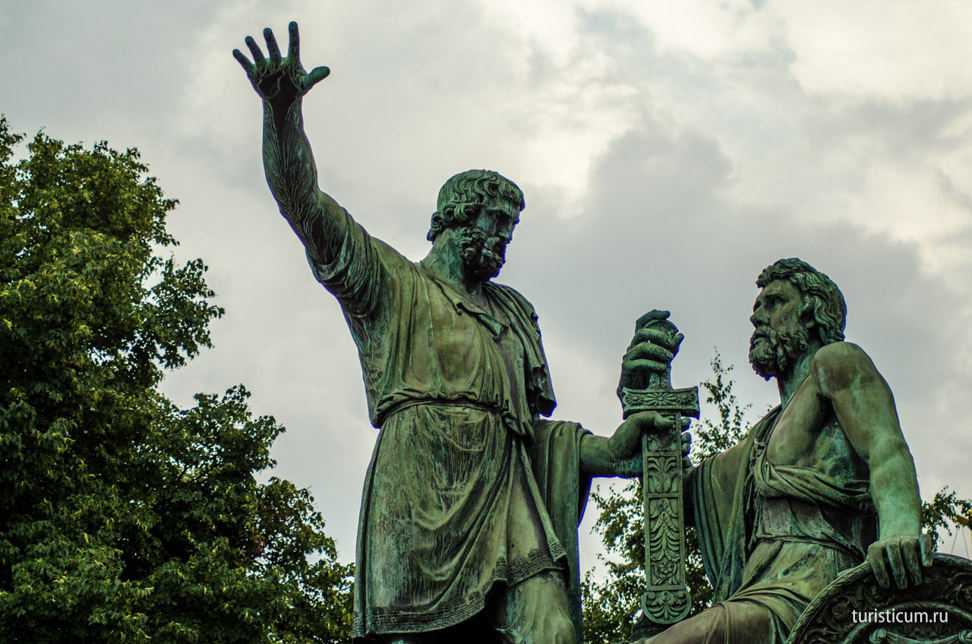
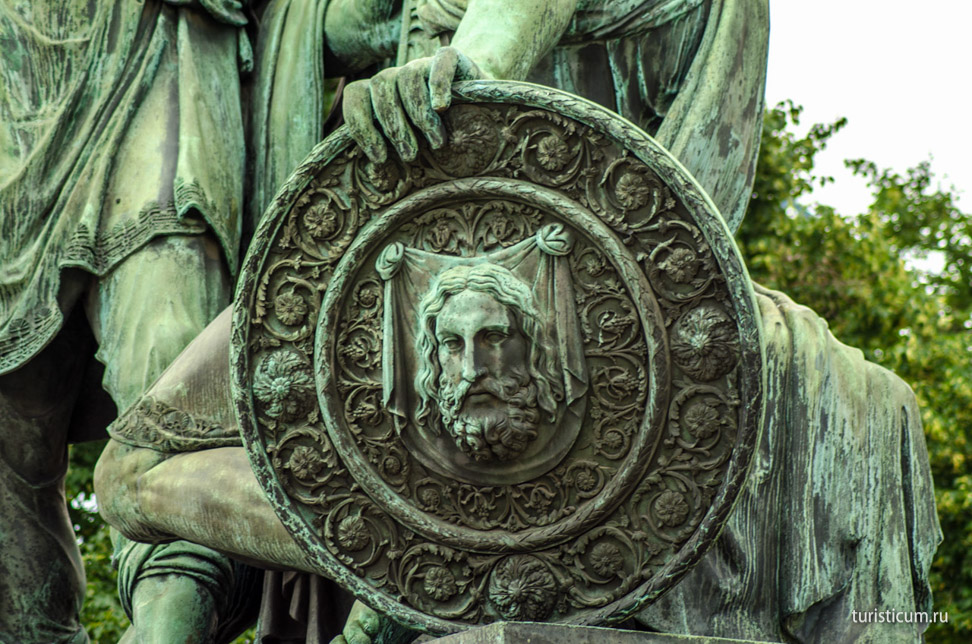
The Square Vasilevsky Slope begins right after Pokrovsky Cathedral and in fact is it still a part of the Red Square.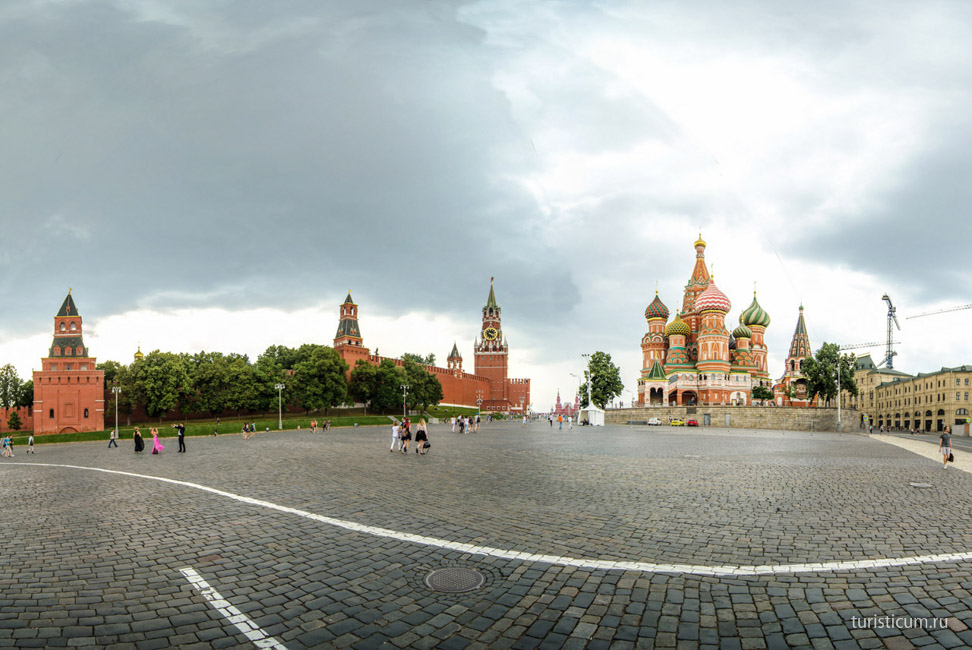
There is no need to say that the bed weather found us at the very end of our day excursion to the heart of Moscow. We hide from heavy rain in a subway, were waiting for the end of the heavy rain and enjoyed the fresh impressions.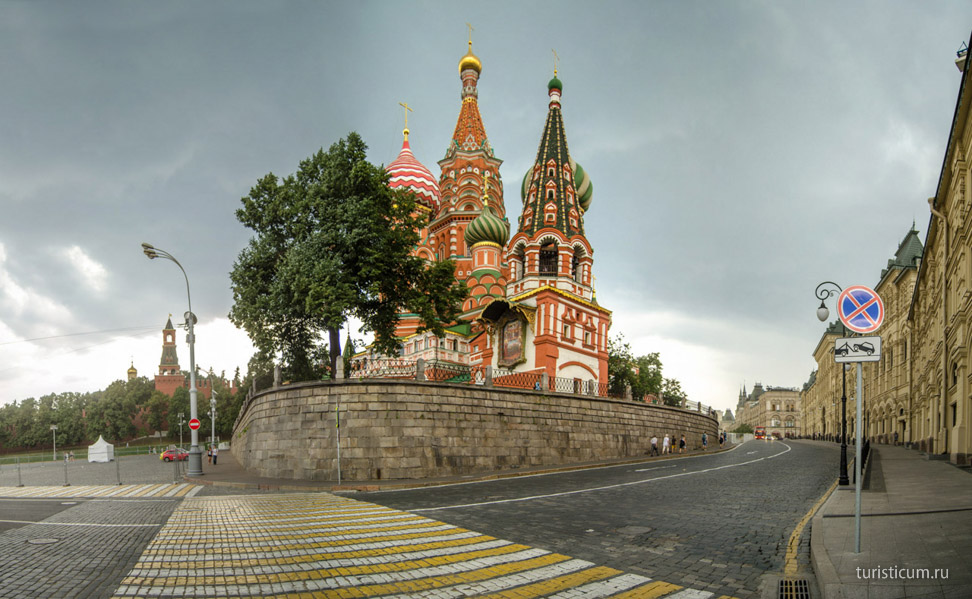
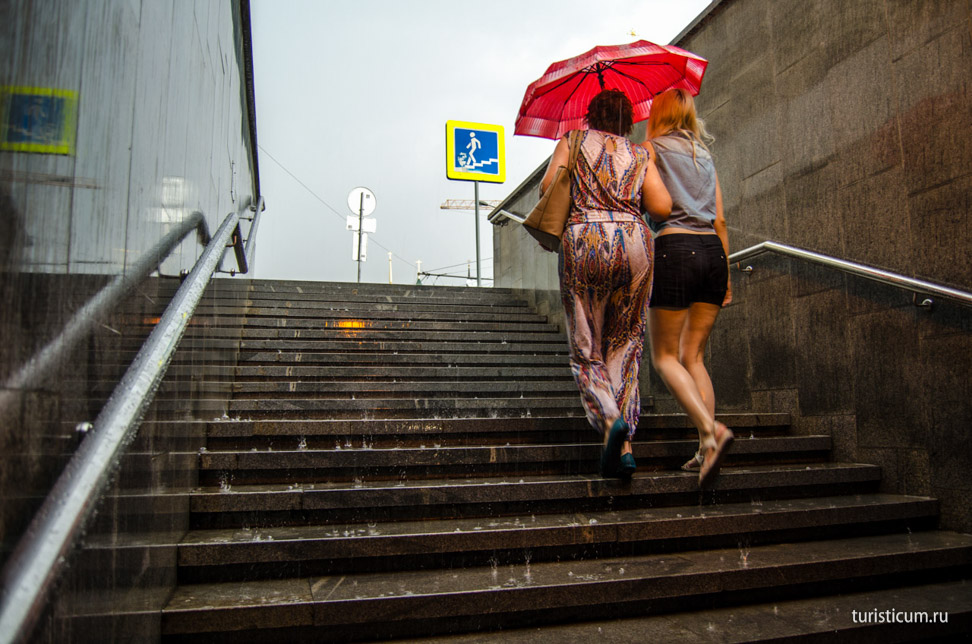
Later on we walked along Varvarka up to the “Kitay-gorod” metro station and further on to our hotel. This outrage of nature always creates lyric mood. Besides it makes one proud of being a part of such a country – the country where such buildings as the Moscow Kremlin with the paving blocks of the Red Square and Alexander Garden with its heat-escaping shadows are still safe and welcome its visitors.